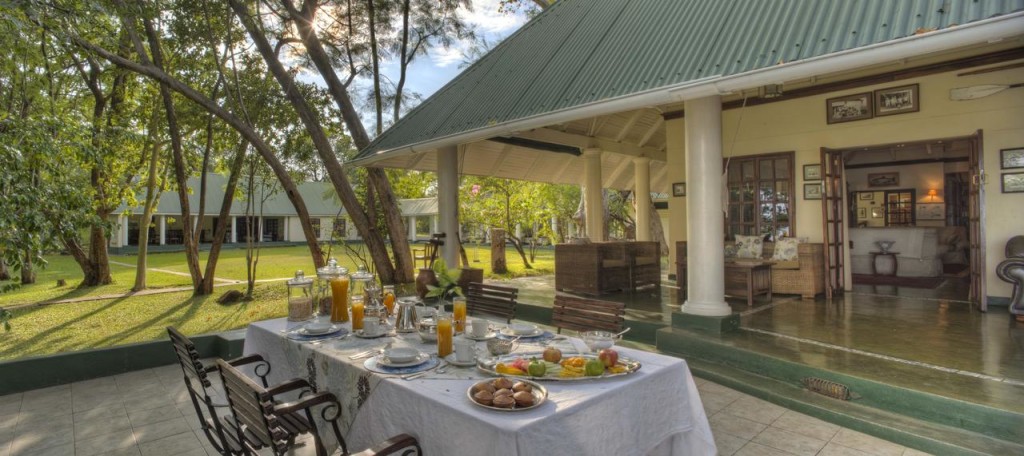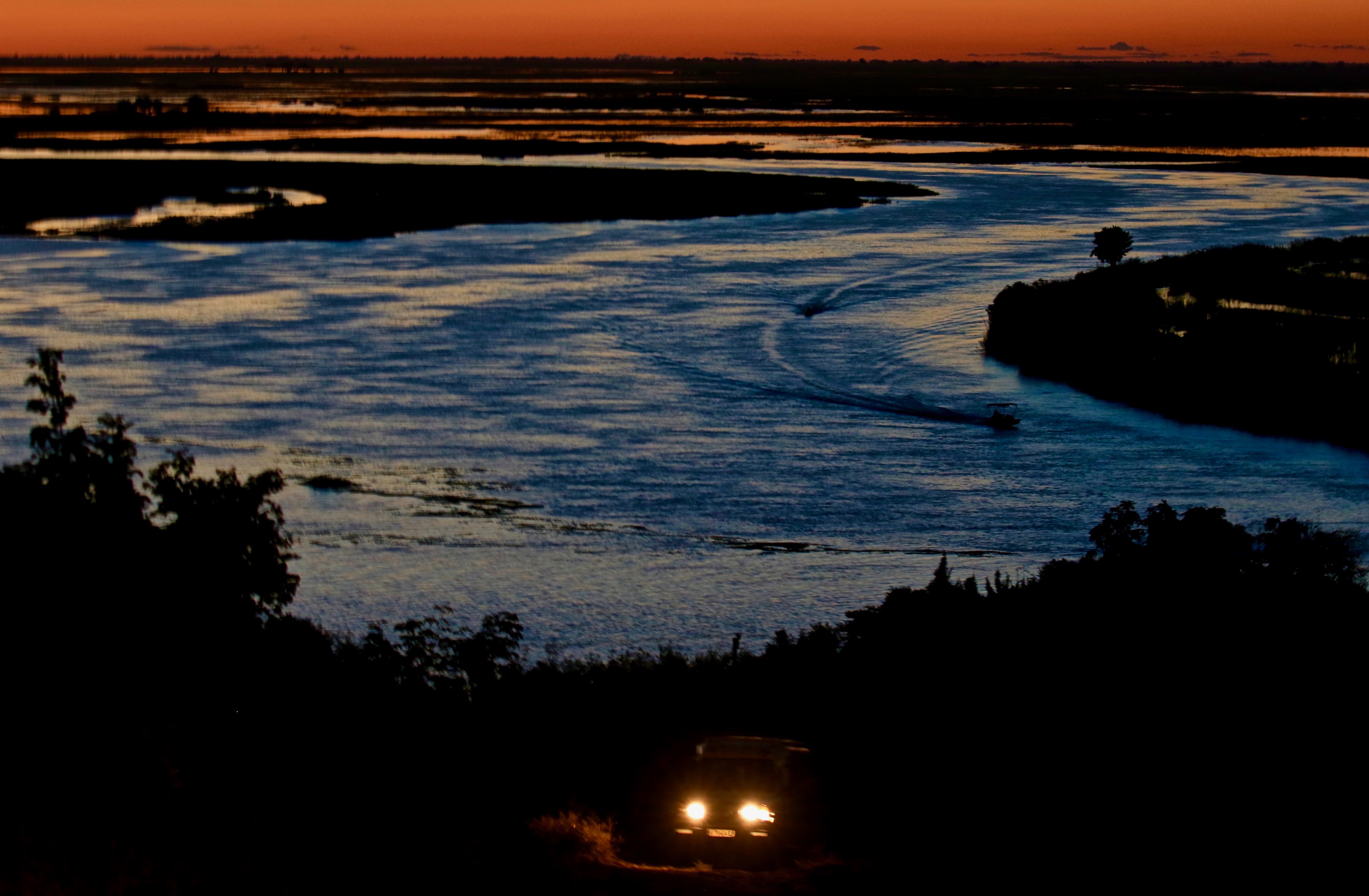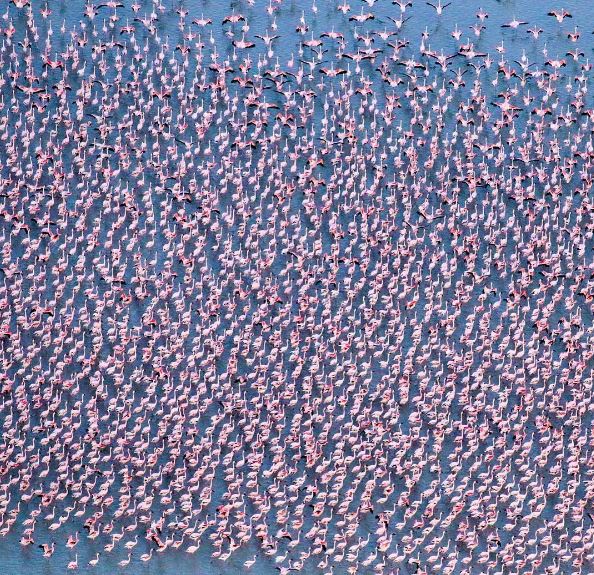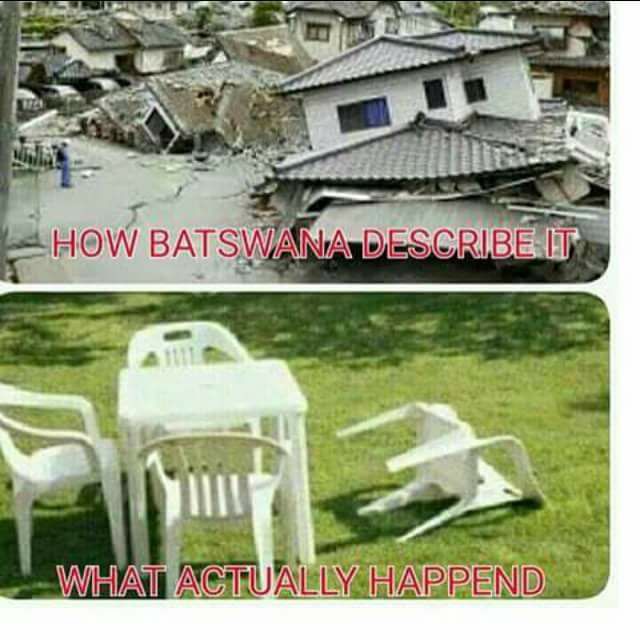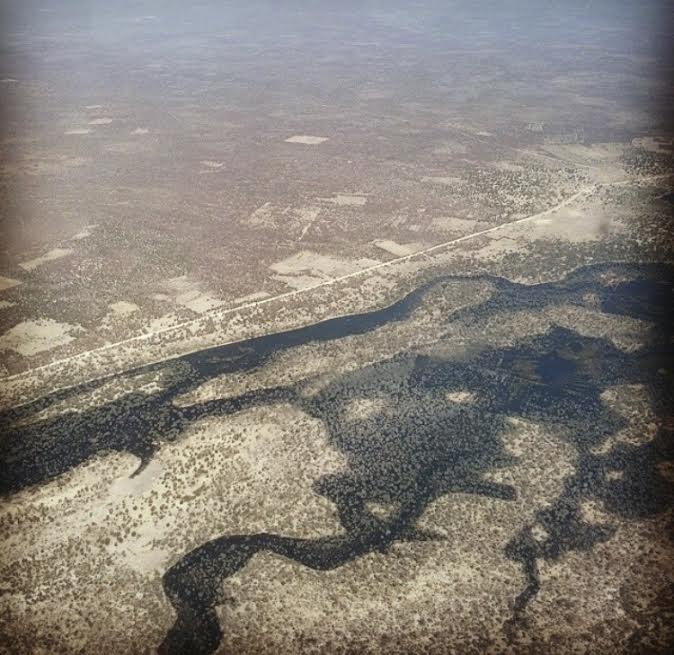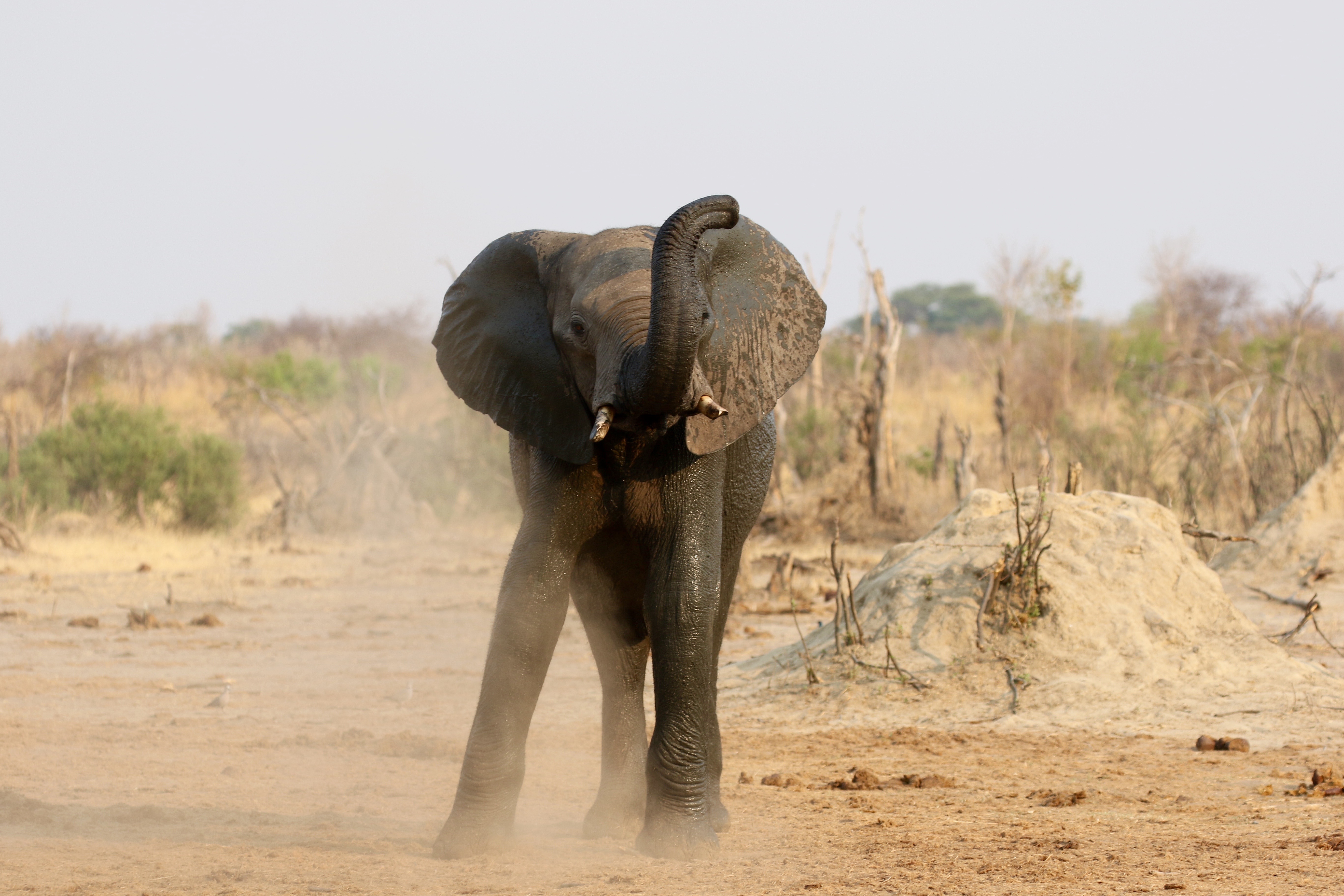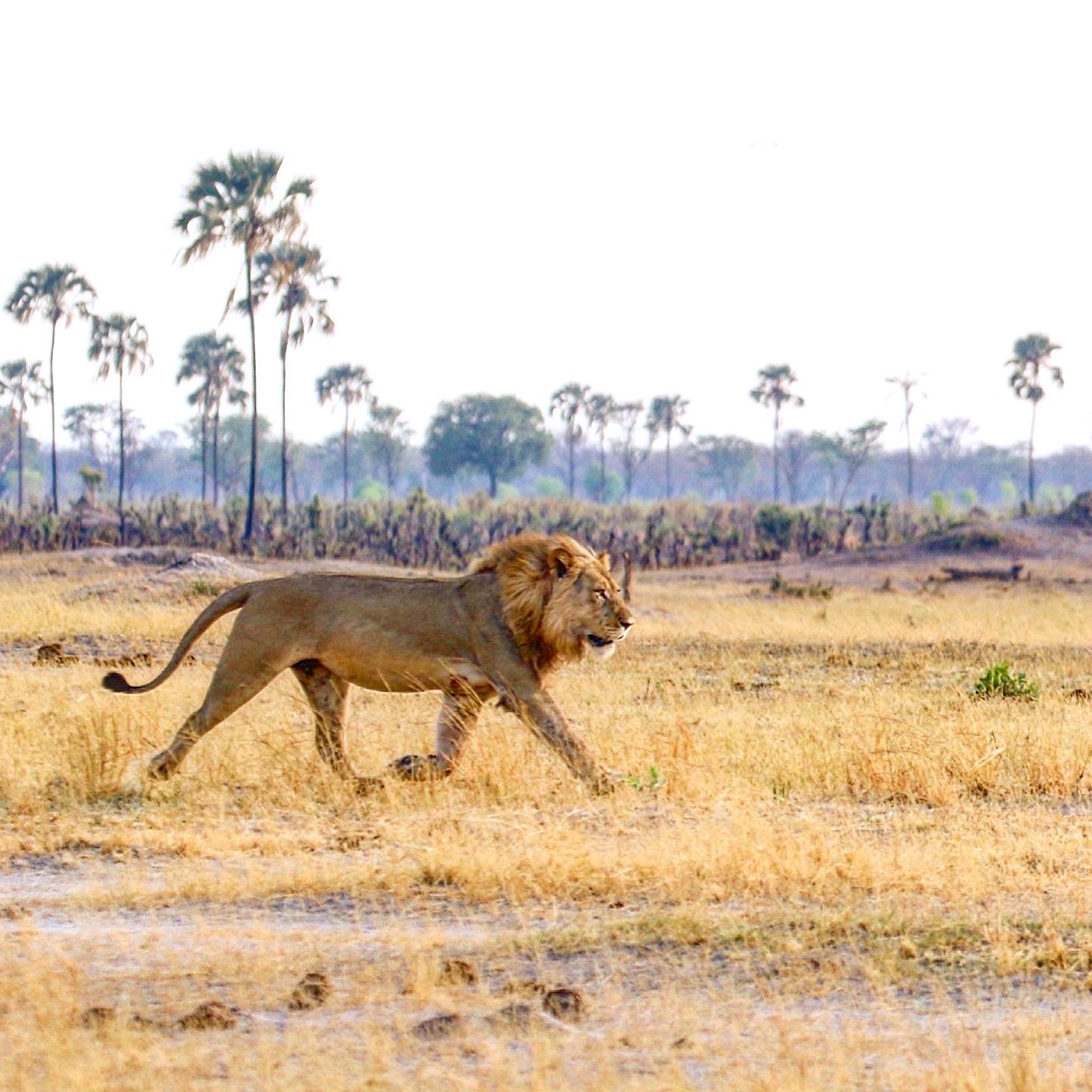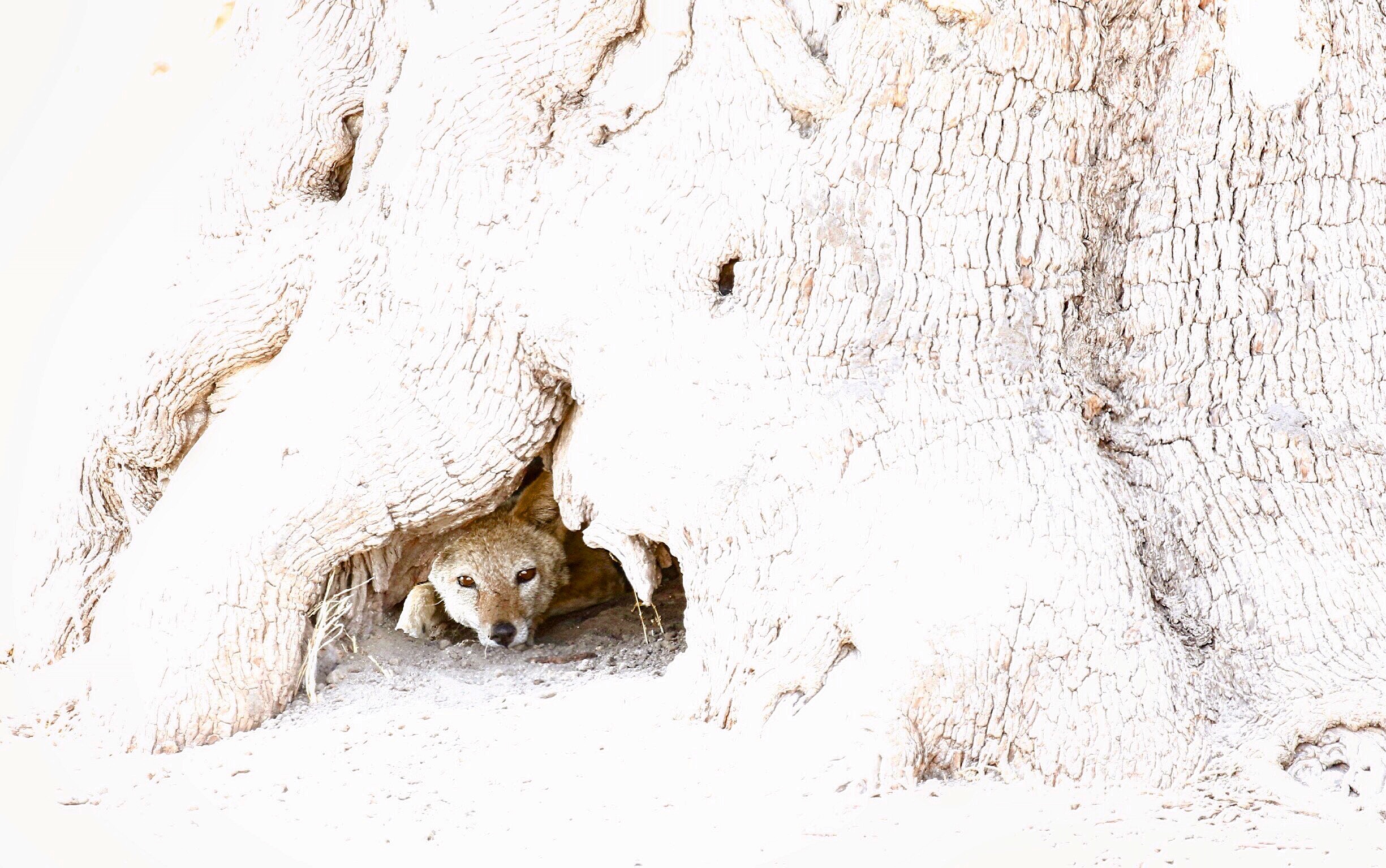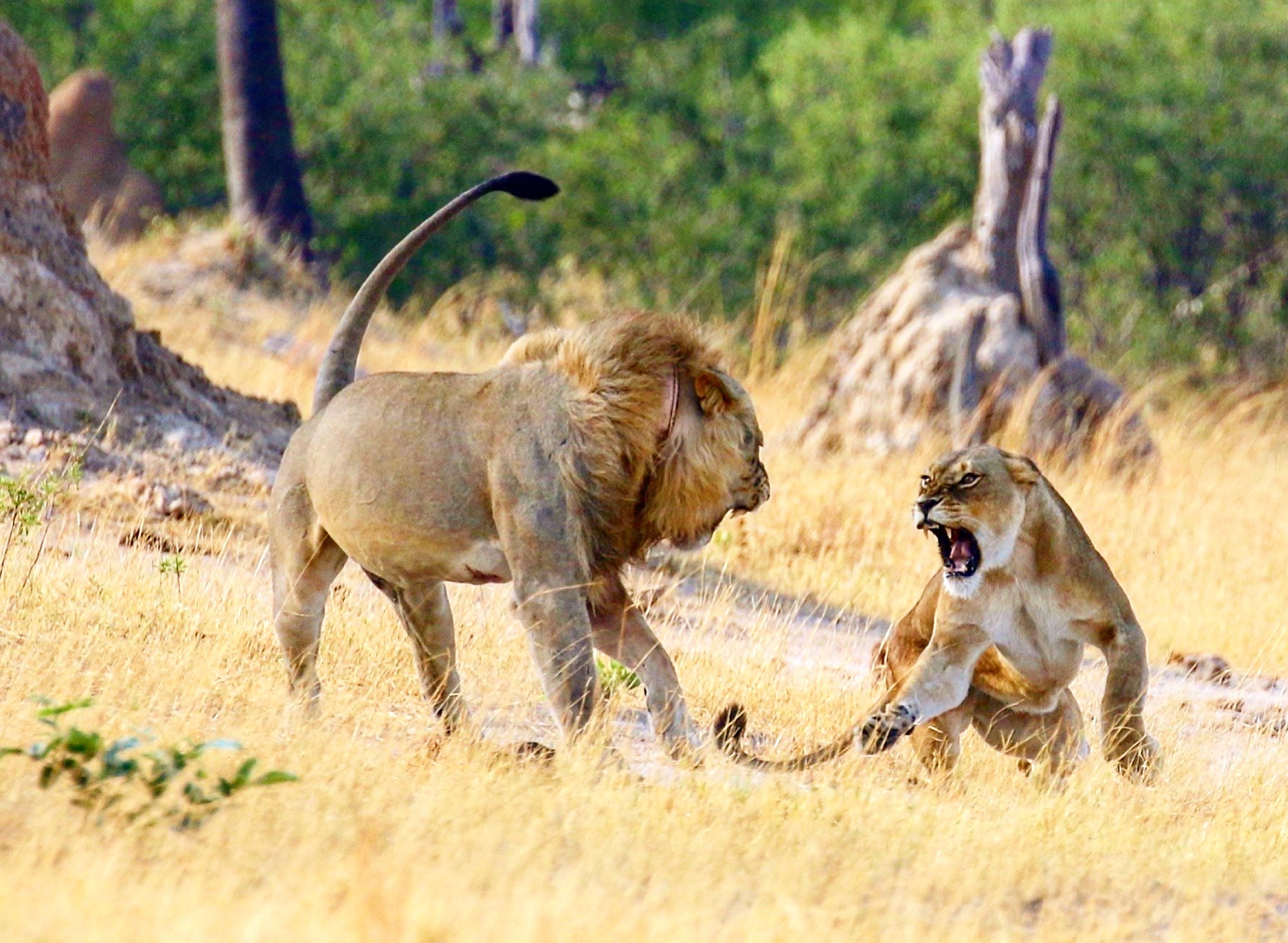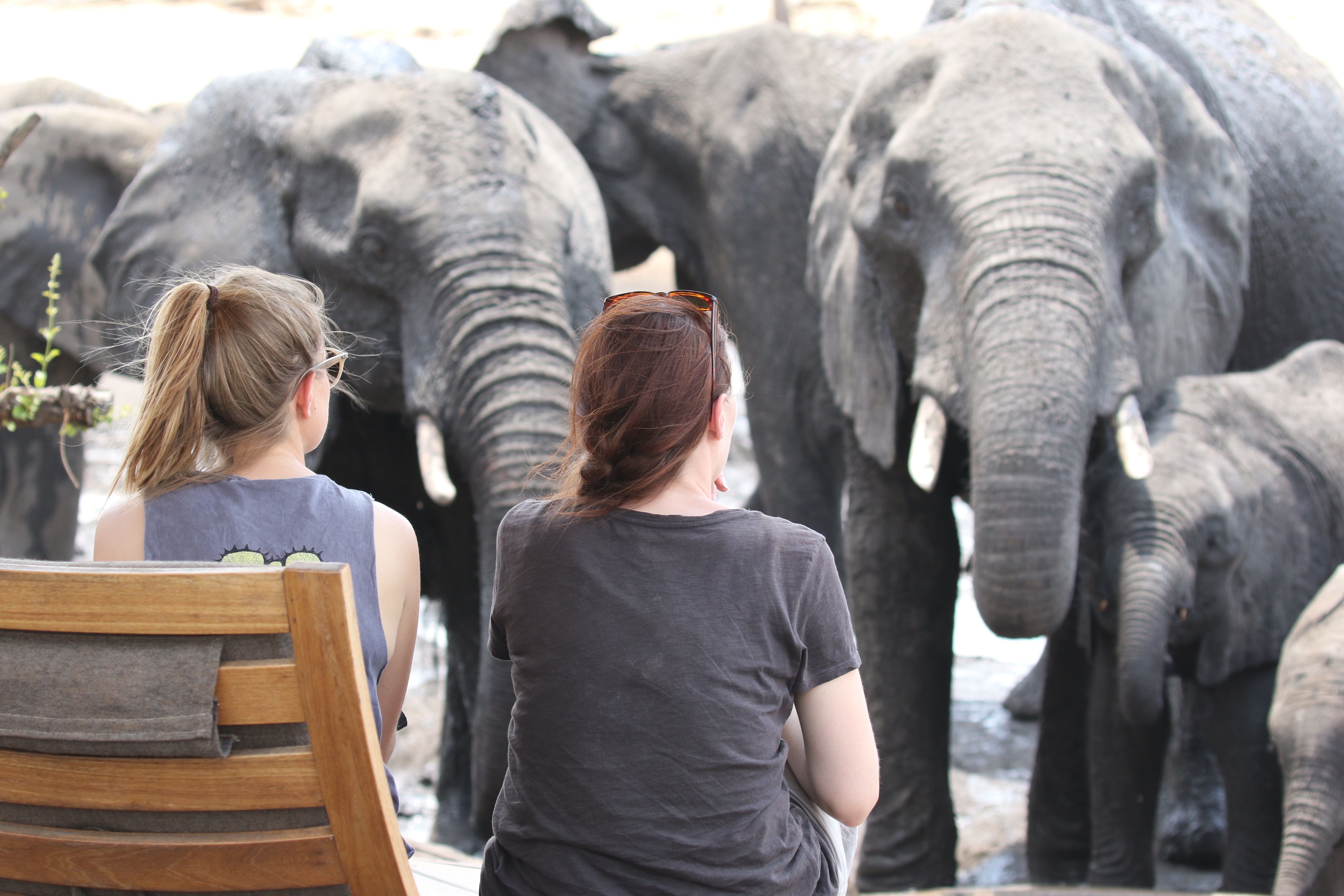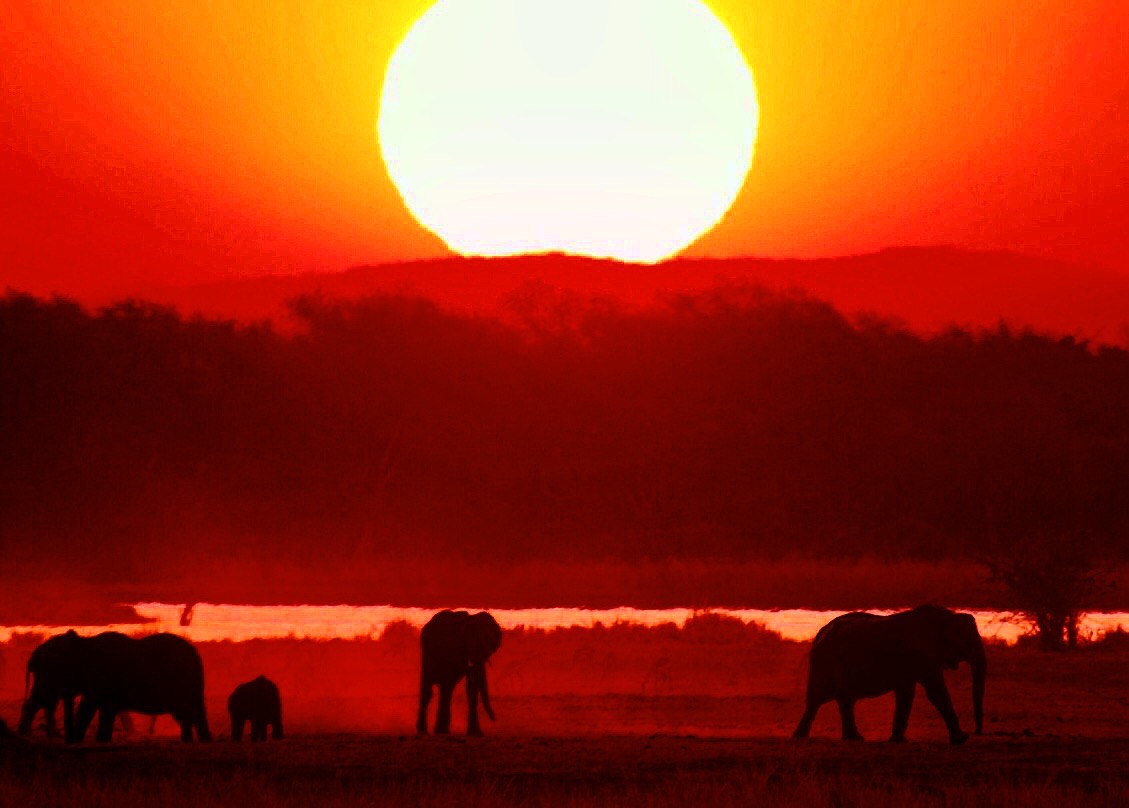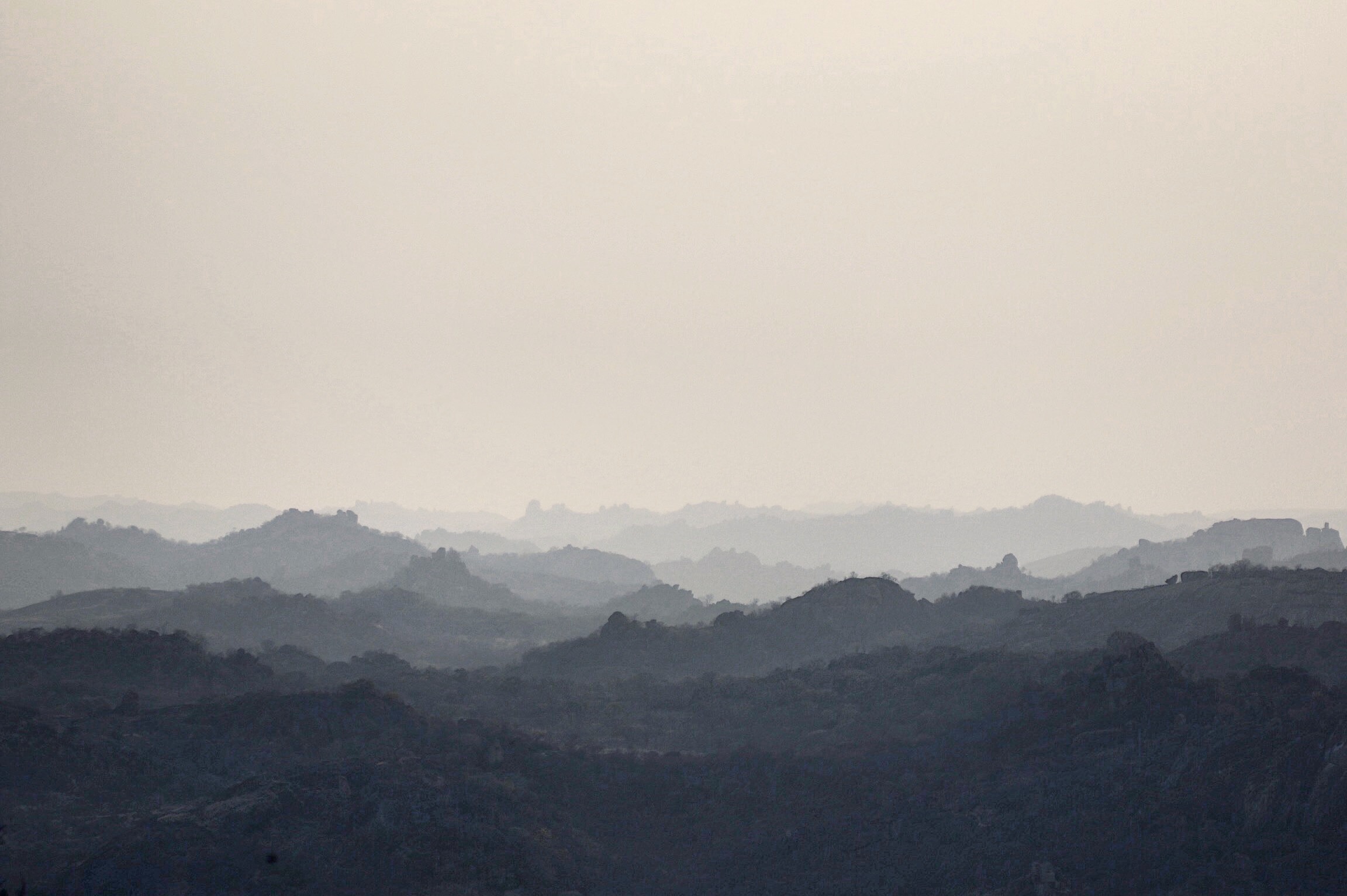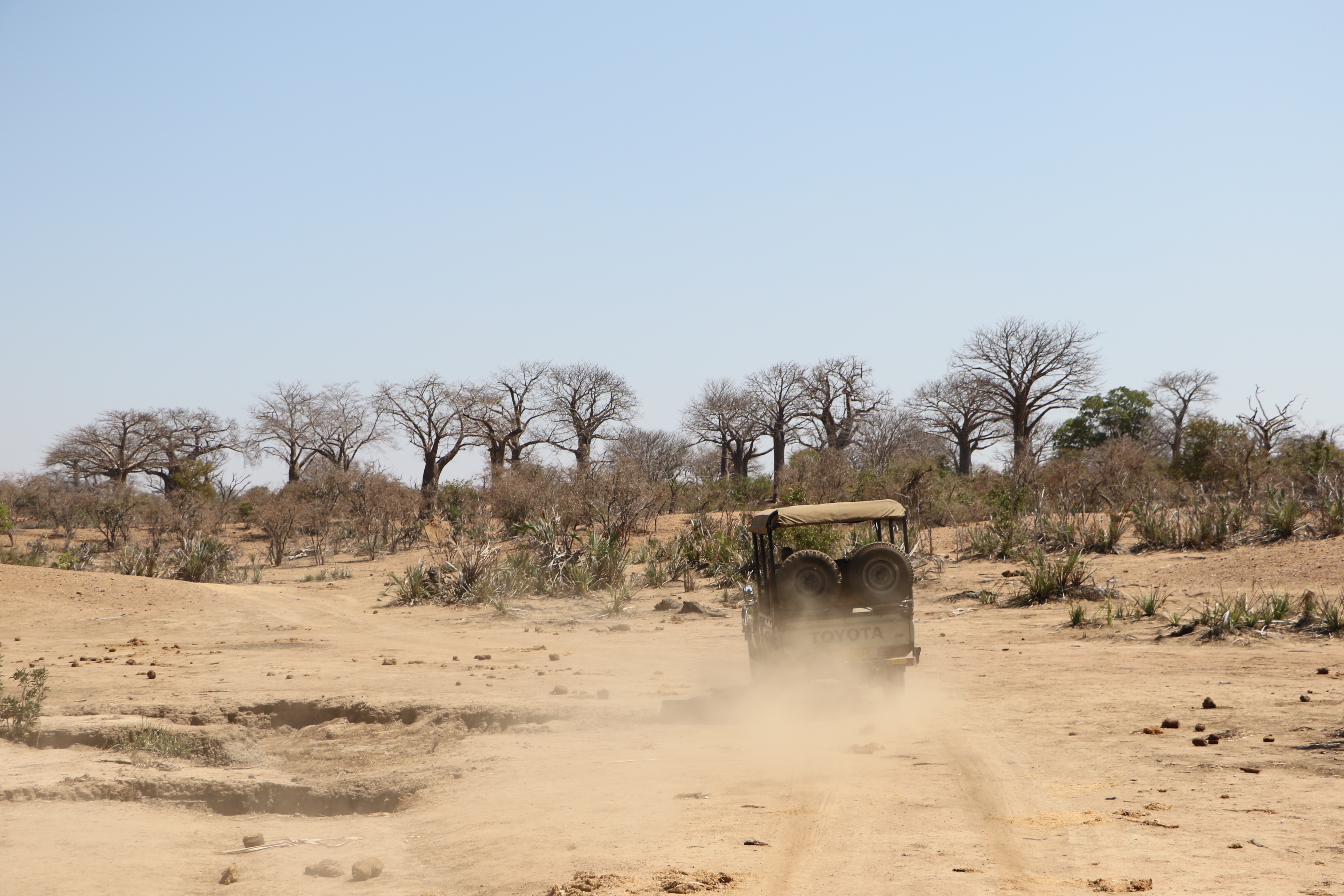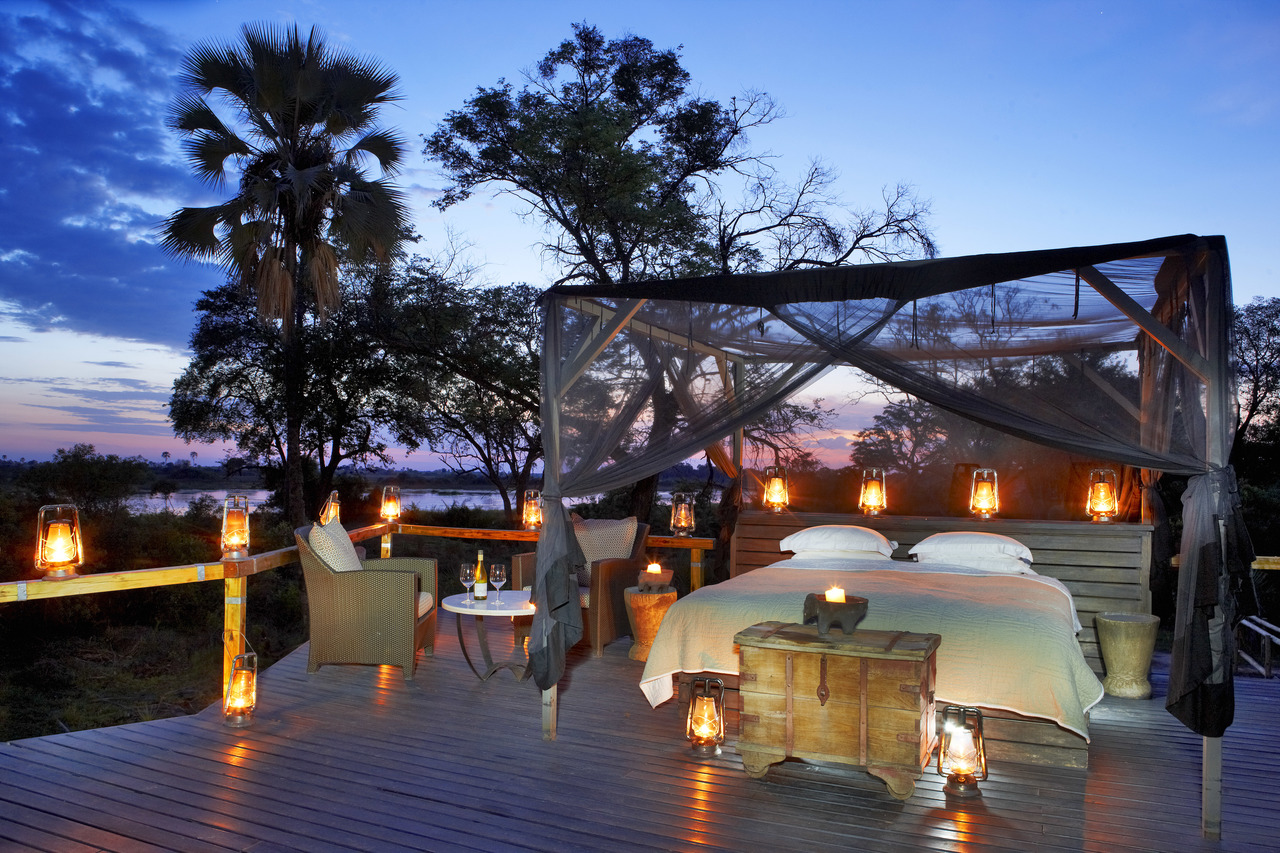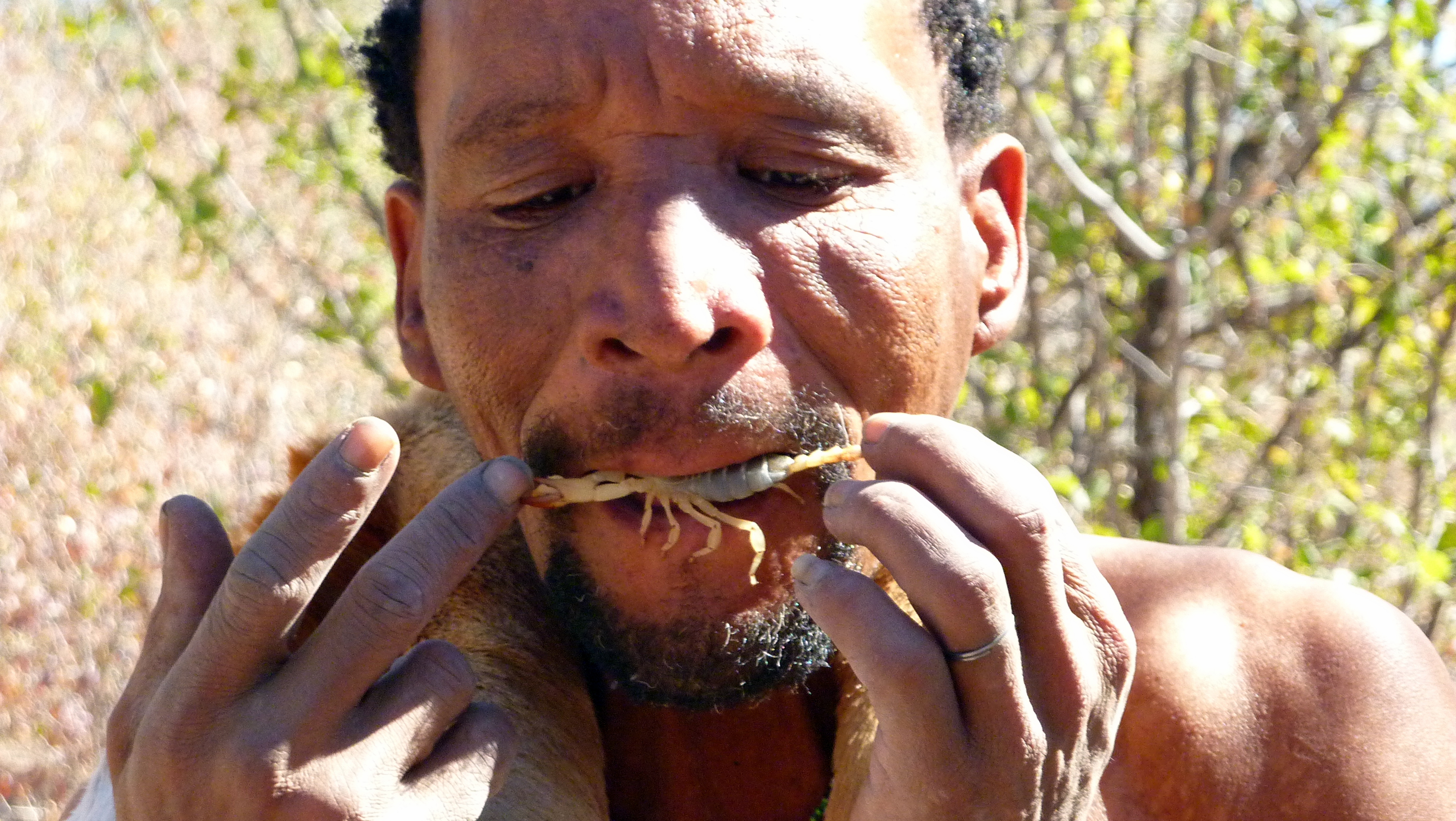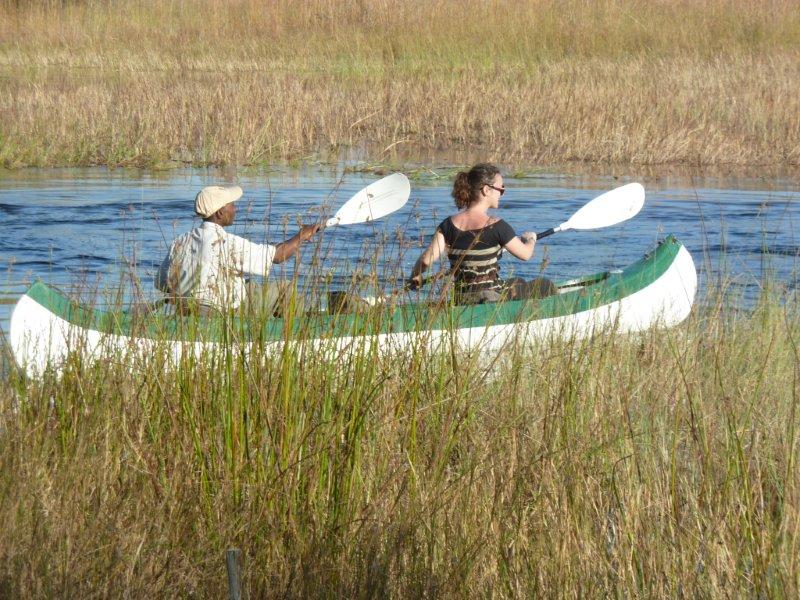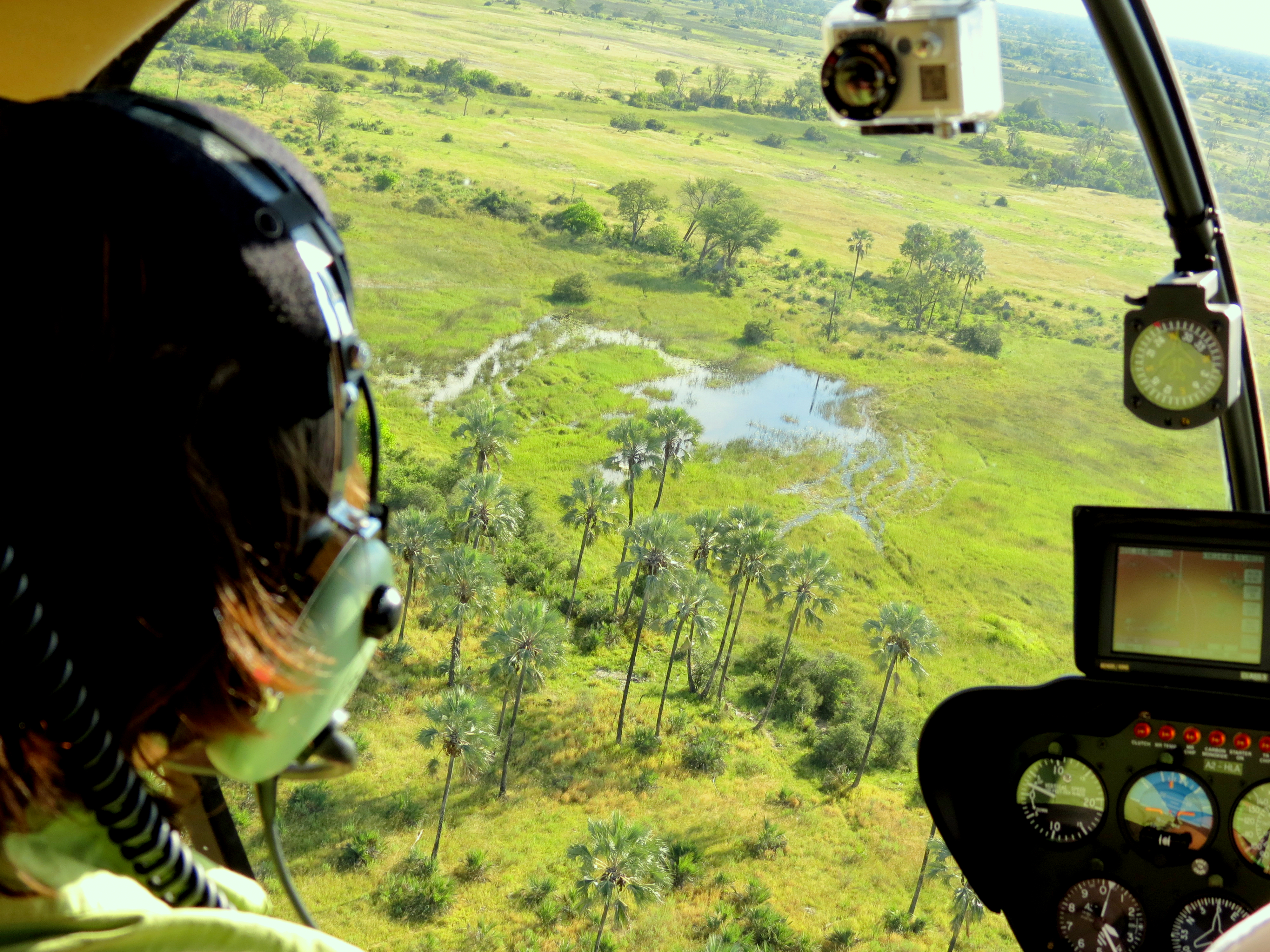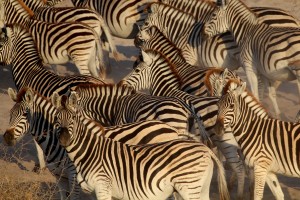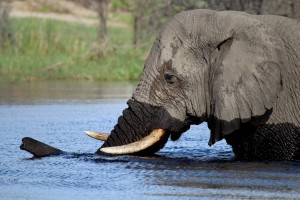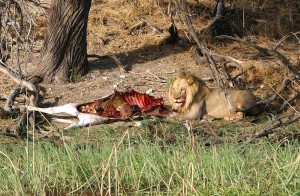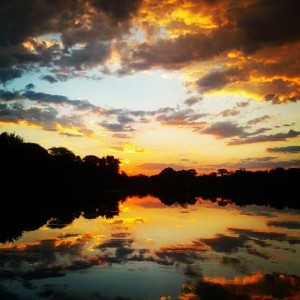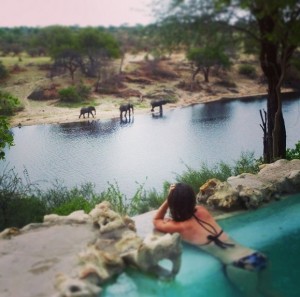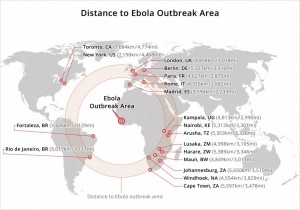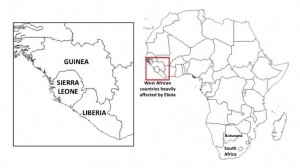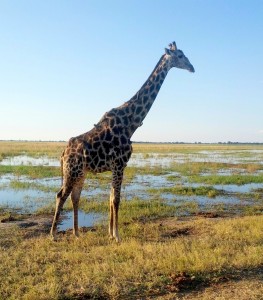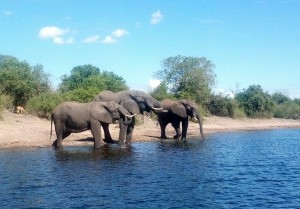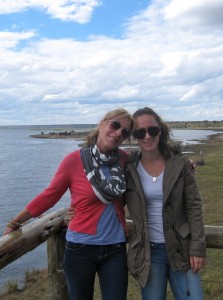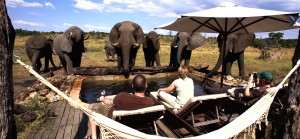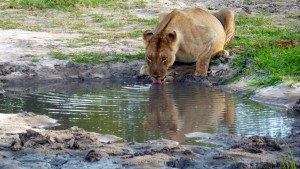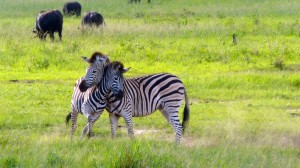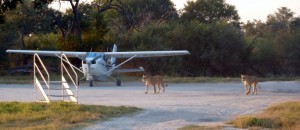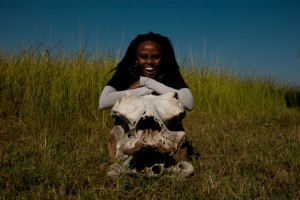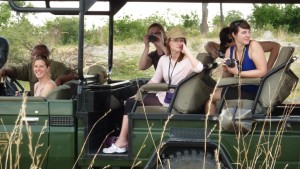The River Club on the Upper Zambezi
Staying at one of the lodges on the Upper Zambezi is a nice reminder that there’s a calmer, more peaceful and service-centric experience on offer than the B&B hotels in Vic Falls town on the Zimbabwean side of the falls offer. That there are still quiet pockets of calm and tranquility near Victoria Falls itself, where you aren’t hearing the buzz of helicopter scenic flights overhead throughout the day.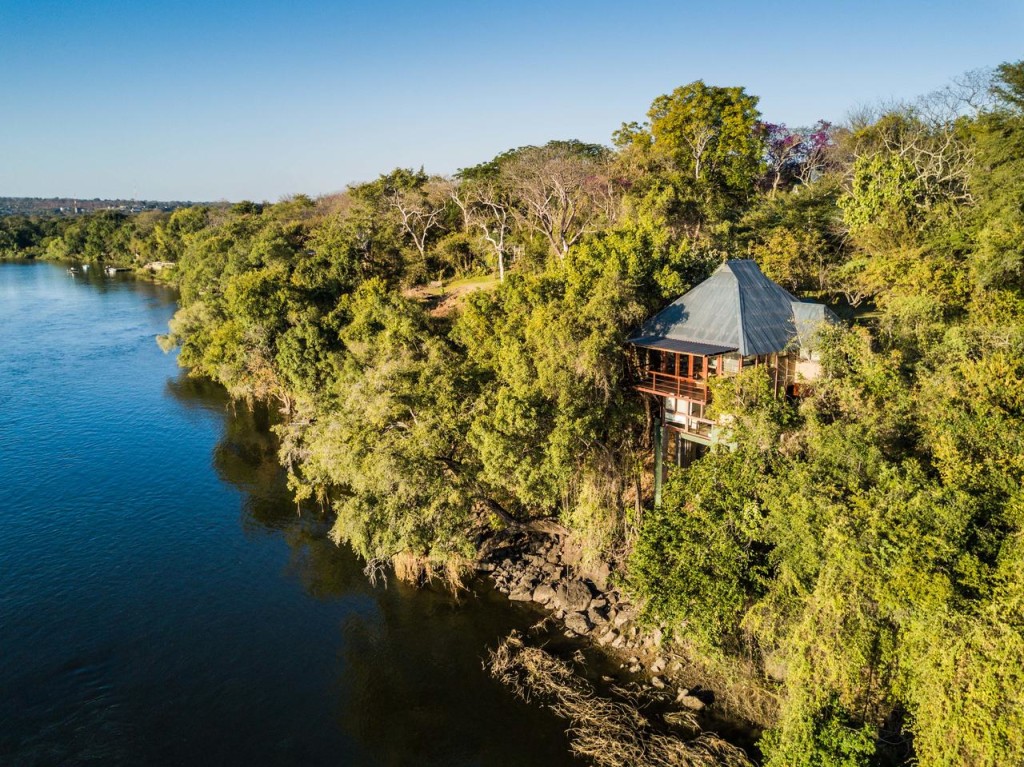
At the River Club, the lodge has an incredible vantage point out over the Zambezi River, from an elevated point of view, where the sun sets beautifully in front of the lodge. The property gives you a thorough grounding in the colonial history of Nothern & Southern Rhodesia (now Zambia and Zimbabwe) as well as a relaxed setting to do as much or as little as you like.
How water levels will define your Botswana safari this year
By now you’ll probably be aware that we’ve had plenty of rain this year in Botswana…so ok, you might ask…but…
What does this mean for a safari in 2017?
Let’s start with the Okavango Delta
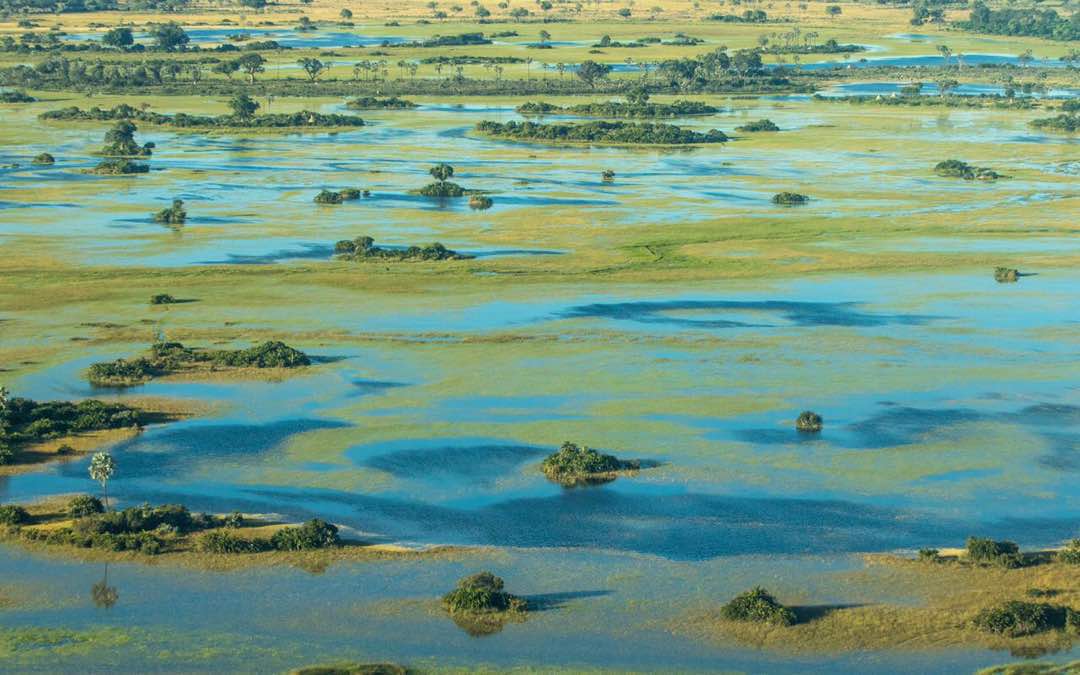 Okavango Delta in full flood, source: Chase Wells (Pilot with Wilderness Air)
Okavango Delta in full flood, source: Chase Wells (Pilot with Wilderness Air)
Normally we like to tell people that local rainfall isn’t so relevant for what happens in the Okavango Delta, as compared to what water comes down from the Angolan highlands with the annual flood.
We’d then explain how it takes several months for all that water from Angola’s green season rains (Nov – March) to travel sloooowwwllyy through the Delta’s alluvial fan, where it will eventually ‘burst the banks’ of the delta’s permanent waterways & spill out into the seasonal (see that key word, seasonal) floodplains. Normally, we expect this to start happening in April / May.
Well, this year we had SO MUCH local rainfall that the floodplains filled themselves up with surface water, before the permanent channels had much chance to be fed with water from Angola and do the job all on its own. Since mokoro activities are often conducted in seasonal floodplains, because they’re safer than permanent channels will be when peak flood deepens them (they’re nice open spaces with plenty of hippo-free shallow water) having these floodplains fill ahead of time meant that many camps which stopped offering mokoro activities late last year due to suitable floodplains drying up, have already resumed them.
Will it last?
Well, for that we need to see what happens with the ‘main’ flood from Angola. Reports from pilots flying over the Okavango are that the main ‘push’ from Angola’s floodwater hit the Jao concession in the northern delta around Easter, and has now reached the southern delta, around the Nxabega / Kanana area. How long those high water levels last will depend on a number of factors: whether we get any more flood water, and how hot September & October get in order to speed up the rate of evaporation later in the year. Having all that rain water around already means that the ‘main’ (flood) event becomes a bit less relevant than normal in determining when mokoro & boating activities can start for the year. Generally, the best bet for mokoro & boating activities in the delta is to from May travel until September, however certain camps can offer these activities year-round and if you’re unsure, our dedicated consultants can advise on which these are.
On to the Chobe Riverfront
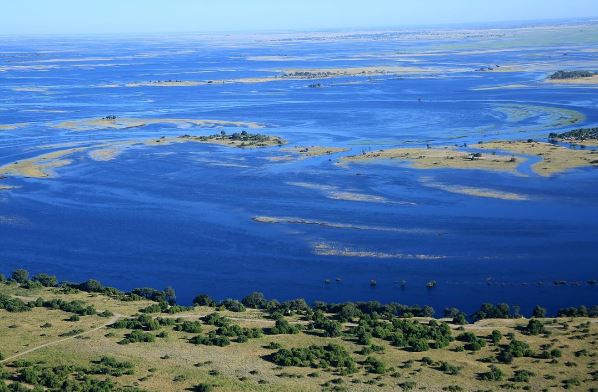
Chobe shot: Chobe Floodplains as of (23.04.17) source: Elephants Without Borders
The Chobe River got plenty of water this year & peaked around Easter (levels are now slowly dropping). This means that certain parts of the riverfront, such as Puku Flats, Lechwe Flats and Kabulabula have been cut off from the main game drive network thanks to rising water. Given these areas are generally more celebrated for their birding, this doesn’t affect the ‘big game’ viewing by road, and birders will still see plenty anyway. As the Chobe Riverfront is known for huge herds of elephants, the increased surface water elsewhere in the bush means that breeding herds don’t ‘need’ the permanent water of the Chobe River to quench their thirst. Elephants are quite clever mammals, and they know that the sooner they hang out in big numbers on the river, the sooner they eat all the ‘good stuff’ that they’ll need later in the winter. As a result, it’ll take a little longer into our winter months this year to start seeing the massive congregations of breeding herds along the water which have become an iconic landmark of Chobe. Despite this, Chobe’s predators are still out and about, and the lion population on the Riverfront continues to do well.
and the Linyanti?
As with the Chobe Riverfront, the Linyanti is also known for its large numbers of elephant, who will also take a little longer to be spotted in huge herds, thanks to the same phenomenon described above. Certain concessions in the Linyanti feature thicker bush than others, so the later rainfall creates denser vegetation, which may result in more challenging game viewing in some areas until later in the season. The waterways in the Linyanti are affected by different processes than the Chobe and the Delta again, so while the Savuti channel has rainwater in it, we’ll need to wait a little longer to know if there’ll be enough of a push from the Selinda Spillway and Kwando/Linyanti rivers into the Zibadianja lagoon to get it flowing again this year. Scientific theories abound that the Savute channel is also affected by tectonic plate movements, and given that Botswana had a pretty sizable earthquake near the CKGR a month or so ago, we’ll wait to see if there’s any knock-on effect for what happens in the Savute Marsh this year.
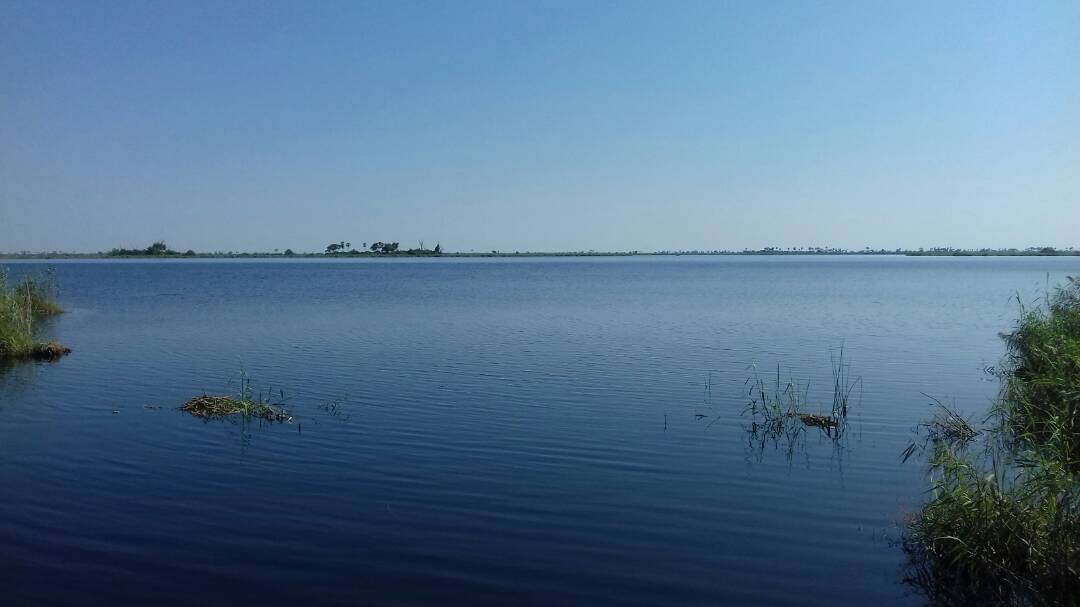
Water levels in the Zibadianja Lagoon as of (12.05.17) source: Storm Keen
What about the desert areas?
Let’s start with Nxai Pan. The zebras stuck around longer than usual, but as of a few weeks ago, have finally started their slow saunter back to the Chobe Riverfront. All that rain resulted in a hippo (of all things!) making the waterhole at Nxai Pan Camp his home. On the Makgadikgadi Salt Pans, there’s enough surface water that Jack’s Camp guests have been taking their sundowners ankle-deep in water and huge numbers of flamingoes have moved into the pans for nesting. Uncharted Africa’s Ralph Bousfield suggests the flamingos may now be semi-permanent residents in the area for the next few years. The affect on activities on the salt pans is yet to be seen, however quad biking and sleep-outs are unlikely to be on offer in the next few months. All that water means the zebras will be slower in moving down to the Boteti River this year and they may be spotted around the salt pans for a while longer yet.
Flamingoes near Kubu Island: Uncharted Africa via #bushboundgirl
Can’t remember it all?
Don’t worry. That’s what we’re here for. We’ll happily advise you on a case by case basis as to what camp and area best suits your requests for travel, depending on your clients’ interests. While all these un-anticipated natural changes are what makes a safari to Botswana so exciting, we can still recommend the ‘best bets’ based on our personal experience for delivering the experience you’re after.
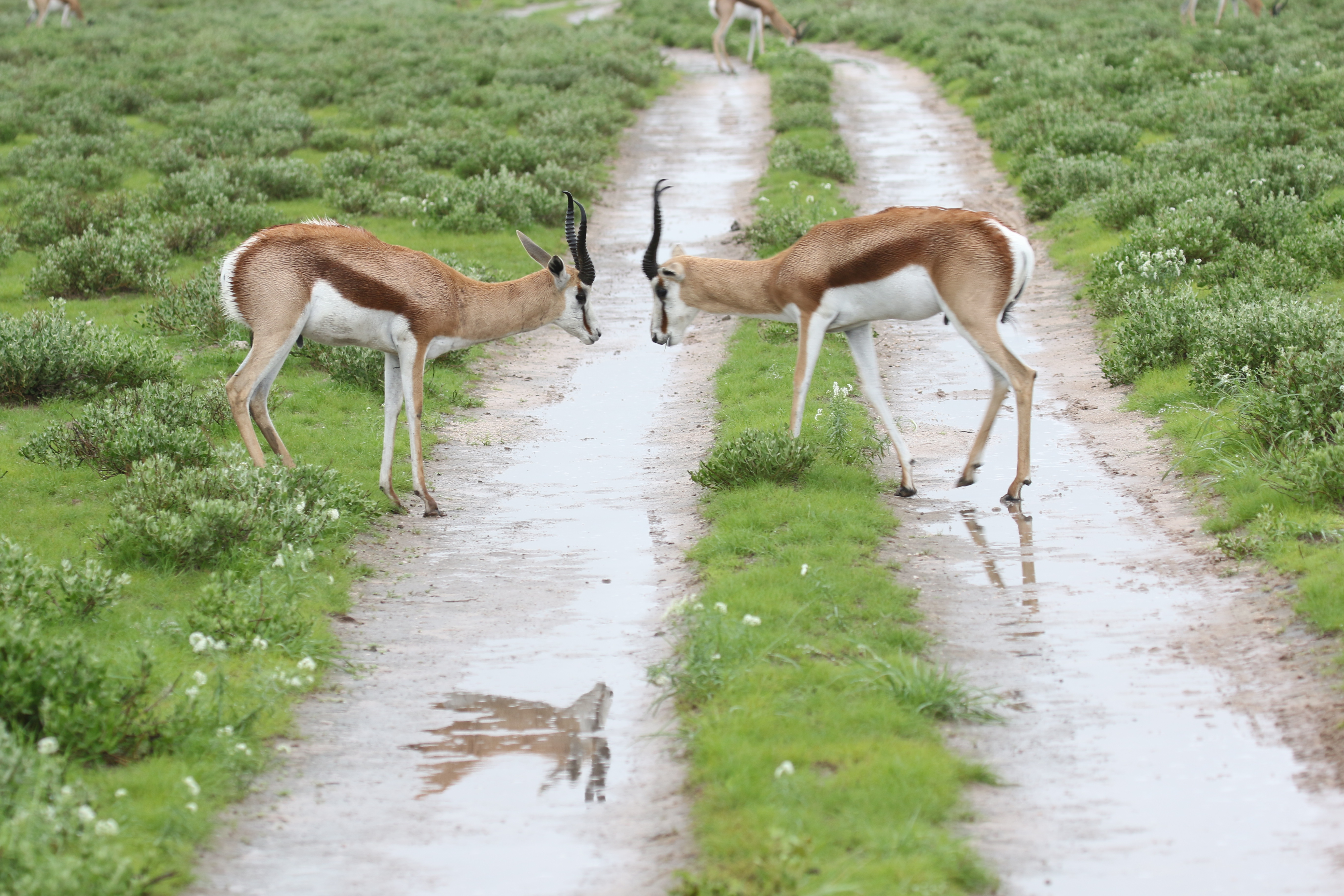
The Central Kalahari full of water and wildflowers during the peak of the rainy season this past January (Photo credit: Clare Doolan)
We felt the earth move under our feet
Yes, it’s true! Botswana had an earthquake!
But, we actually have them quite often. It’s just that we never really feel them. Although the quake had a 6.5 magnitude, the only real disruption to our lives was the bleeping of a thousand cell phones during dinner time, as everyone asked “is it just me, or….did anyone else feel that?”
And, sorry to say – that’s as exciting as it got.
Why is that? Well, it turns out that living in the Kalahari Sand Basin works out quite handy in minimising the effect of tectonic plate movements.
Those same sands that fill with the Okavango’s waters & give us a reason to sweep our floors daily, also act as a giant shock absorber. If you were to take a shovel and start digging in the centre of Botswana, you’d be several kilometres down before you hit bedrock. In the middle, what you’ve got is sand & only sand. When tectonic shifts happen deep down below, the vibrations get muffled by all of that sand, so even if they’re ‘big’ earthquakes, they’re too disrupted by the time they reach the surface to have much impact.
Having said that, most waterways in Botswana are influenced by fault lines & tectonic plate movements. The Okavango Panhandle is channeled between two faultlines, then spreads out into the alluvial fan & abruptly stops at the Thamalakane fault line which then diverts the watercourse to the Boteti in years of plenty.
The Kwando River hits a big fault line (the Linyanti) which pushes the water out into the Linyanti Swamps, forces the river to change direction (and names) to become the Linyanti River (and later, joins other waterways to become the Chobe).
Interestingly, no-one really knows how the Savute channel works & what makes it’s flow stop and start, but theories abound that it’s shifting tectonics which are mostly responsible. Water in the channel has just passed Wilderness Safaris’ Savuti Camp in the last week or so, so let’s see if those earth tremors give it the push it needs to fill our Savute Marsh this year!
Otherwise, keep calm & carry on. Safaris continue as normal – Botswana has just been busy moving heaven and earth to impress her travellers!
Should You Visit Zimbabwe?
It’s incredibly hot, and unreasonably dry in Hwange. As I sit and wipe the September salt from my eyes (in any other month it might be sweat, except the moisture evaporates before it can form), I wonder if a bikini might’ve been more sensible game drive gear, rather than the standard-issue khaki I’ve got on.
Typically, the argument for well-intentioned shades of light green and tan is that it’s practical. It’s sensible for bush walks, the lions won’t charge you (since you can convincingly impersonate a bush) and you can’t blind fellow safari goers with offensively clashing colour combinations. The problem though, is that as soon as your sweaty thighs have been rubbing on a canvas-covered seat for three hours, hey presto, you’re half transparent. Come sundowner time, I’m going to have to stand up and risk my fellow safari-goers thinking I’m incontinent – despite the fact that I’m a good two decades younger than most of them.
These are the superficial thoughts cruising through my pan-fried mind as we come across a breeding herd of elephants on the Dete Vlei Line. My mind is wandering, until these guys who had seemed pretty chilled at first, start forming a circle around a small calf, and then push two three year olds behind one of the bigger ladies in the herd. The matriarch stares at us, measures our composure and assesses the potential threat we pose. To be fair, they’re just as hot and bothered as I am, probably even more so. It’s been a long, dry winter, which is now heating up tremendously as the summer months approach. The bush is bare, there’s very little food, and the rain required to grow a larder large enough to feed 40,000 elephants is still at least a month off.
“These guys are under stress at the moment’ our guide “Zimbo” explains. Officially, we could put this down to another long and stressful dry season. Unofficially, Zimbabwe’s government have been separating the youngest members of Hwange’s breeding herds from their families and rounding them up into bomas where they’ll be housed before being shipped off to Chinese zoos, ‘the government says it’s restocking Chizarira National Park,” Zimbo says, but we soon find out they’re only capturing the youngest members of Hwange’s herds. This is not standard policy if you plan to re-stock another park with dwindling numbers of elephants. You just don’t leave behind the adults who’d need to school their young in the art of bush survival against a new and unknown terrain.
If you’ve ever spent more than a few minutes with a wild elephant, you’ll know how intelligent they are and how strongly they cling to their social structures. To an elephant, family is more important than anything else. Not only that, but elephants are intuitive enough to know when they’re under threat. From the second we pulled up, these guys were busy determining whether we meant to take their young or not.
Suddenly, the dilemma of my sweaty chaffing and temporary discomfort pales into the background. I’m left staring a serious conservation issue in the face – one that polarises people into different camps of opinion about whether or not to travel to Zimbabwe. This is an issue that requires more than “likes” and “dislikes” on social media, and Zimbabwe’s tourism industry is thoroughly aware of it. Not only that, but Zimbabwe’s operators are passionate about the fight, and actively seeking out conservation-minded solutions – if only they had more tourism dollars to do it.
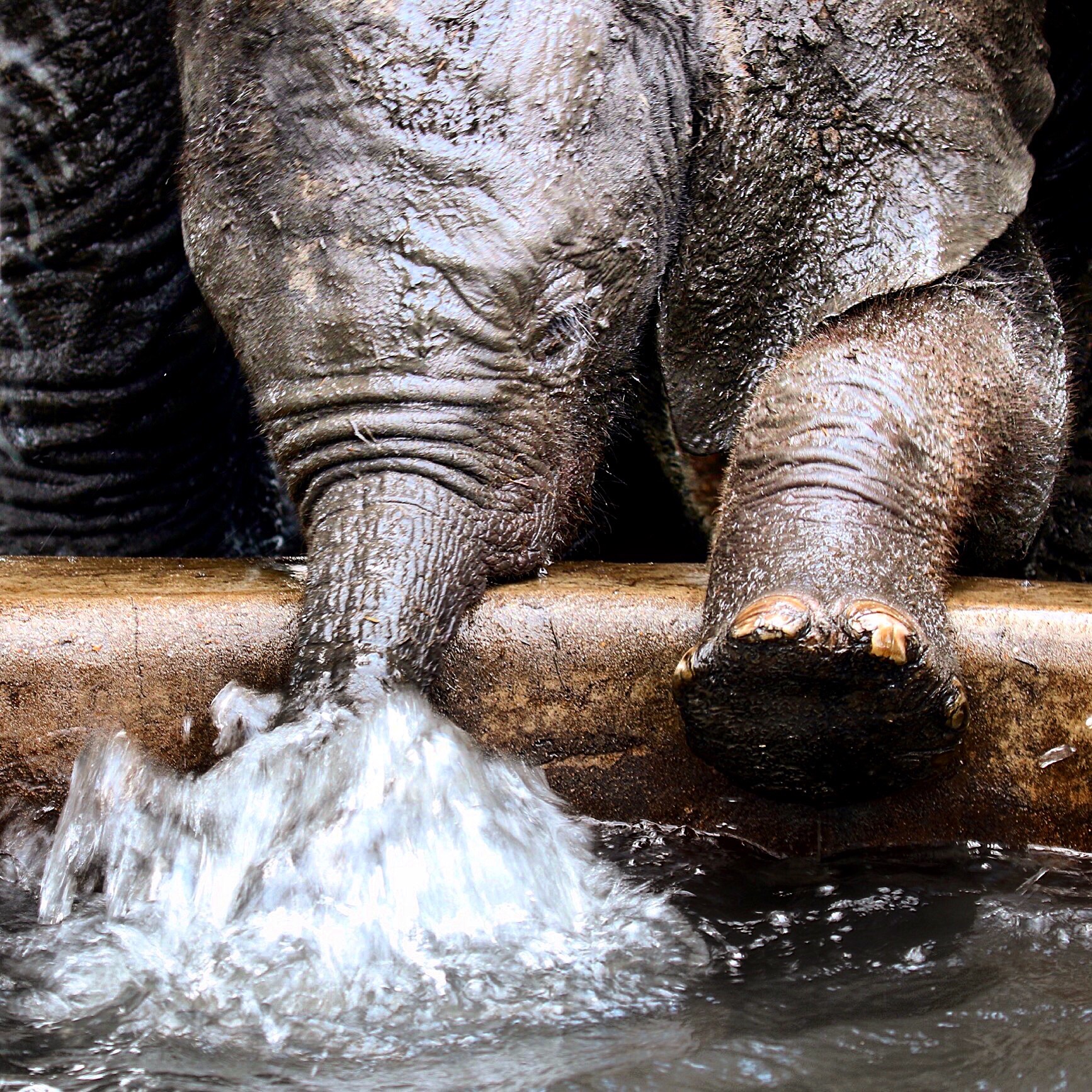
One of Hwange’s elephant calfs makes short work of a lodge swimming pool’s water during the dry season this October.
THE MUGABE EFFECT
Everybody loves a baddie. Ask around, and you’ll quickly find Mugabe is the kind of guy people love to hate. Bob’s talent for misappropriating public funds may not out-match that of South Africa’s Zuma, nor might his brand of tyranny overshadow Russia’s Putin, but he’s certainly had the benefit of a few more decades to hone his reputation, as well as to develop a hefty anti-following.
Thanks to Bob’s surly disposition, and his refusal to govern Zimbabwe by usual democratic methods, there are many travellers and tour operators who feel a moral duty to discourage travel to Zimbabwe. On the surface, the motivation to do this seems noble – starve the guy of cash and knock him off his high horse. The problem with this approach is that it ignores two very significant factors.
#1: MUGABE DOESN’T NEED YOUR MONEY
He gets enough from the exorbitant taxes imposed on his citizens and the decades of foreign aid he’s already whittled away into bank accounts abroad. Mugabe’s pension fund is well and truly established, despite his lack of intention to ever really retire. A lack of income from tourism will not be the motivating factor that prompts old Bob to secede.

Mugabe might be a menace, but his antics are transparent enough that most Zimbabweans can get the best kind of humour out of a bad situation
#2: ZIMBABWE NEEDS YOU
Of all the places I’ve travelled in Africa (and I’ve been to 21 of her countries – which is not all of them, but it’s enough) I’ve never met more committed and passionate conservationists than what I’ve found within Zimbabwe.
Zim’s lot are a tight-knit bunch, who for many years have drawn together under dire circumstances, made a plan with whatever they’ve got to hand and often used nothing more than sheer bloody-mindedness to protect their natural resources against an alarming lack of support from their own government.
Zimbabwe’s tourism operators have taken on the task of grading and maintaining roads, both for anti-poaching patrols, as well as to establish game drive networks. They pump waterholes during the dry months to keep wildlife sustained and to prevent populations of already threatened species diminishing even further. Zimbabwe’s tourism operators use significant chunks of their income to feed, educate and employ people from villages bordered by wildlife areas, in an effort (which has been shown to work) to curb subsistence poaching.
Ask any Zimbabwean operator and you’ll find that the battle is not just hard-won, it’s also funded by tourism dollars alone. Without the much-needed cash injection from tourism, waterholes would run dry – killing wildlife, safari camps would go abandoned – opening up tracts of land to unchecked poaching, and Zimbabwe’s natural resources, as well as it’s people, would face an even more uncertain future.
With the help of tourism dollars, Zimbabwe’s safari operators are able to help fill the void left by a negligent government. If you want to have the greatest possible impact on Zimbabwe, then visit – and empower its people to achieve even more, in spite of the man up top.
THE GUIDING IS UNBEATABLE
Until a couple of months ago, if you’d asked me how I might react to standing in front of two lionesses on foot, I’d tell you I’d love to do it, but I’d anticipate feeling a little bit shaky about it. Add to this a big male lion that would be SOMEWHERE around, but we wouldn’t be sure QUITE where, until he grumbled from the bush behind me, and I’d be happy to guess that it would be brown trousers time. Somehow though, when faced with the situation in reality – that’s not how it ended up playing out.
Earlier in my safari with Singita Pamushana (in an under-appreciated corner of Zimbabwe called Malilangwe) our guide Mark had introduced us to his tried and true method for fitting in with the wildlife. “I talk to them, ok? You might think it’s weird, but for me, it works. The trick is never to sneak up on a lion. Always let him know you’re there. I’ve been doing this for years and the guys here (he was talking about the wildlife) are used to my strange ways. Just bear with me.”
And so it was, that I found myself in the middle of a casual chat, when I would’ve expected to feel a cold sweat coming on instead. “It’s OK big boy. It’s alright.’ Mark says ‘We’re going. Don’t worry. We didn’t see you there. We’re just going to go now, ok?’ then, as our lion continues rumbling, flicking his tail back and forth as if Mark has just made a pass at his lady friends, he instructs us ‘ok, we’re going to leave him now, he’s a bit grumpy, just follow my lead.” Despite the theatrics, Mark had made such light work of the situation that I didn’t even skip a heartbeat. In some ways it was a little disappointing not to feel the expected rush of adrenaline, but in reality, it was also a pleasure not to have to deal with the extra laundry.
This is the talent of Zimbabwe’s guides. They spend years and years training under a system so rigorous that it’s gained a kind of notoriety. Ask any experienced guide whether they’d like to sit Zim’s test and it’s almost guaranteed that the idea will give them a kind of buttock-clenching anxiety. Guides in Zim are expected to know all sorts of everything, from biology, astrology and geology, to exceptional hospitality skills. Ever had a guide climb over the top of you, into the back of the vehicle, so he can pour everyone gin & tonics at sunset without having to drive away from an impressive lion sighting? I have, and it only would’ve happened in Zimbabwe (kudos for this trick go to Albert of African Bush Camps).
In Zimbabwe, you’ll learn the personal stories of the wildlife you encounter, including everyone’s names and what their family trees look like. It’s exactly this in-depth level of guiding that drew such attention to the plight of Cecil the lion, famously shot in Hwange a year and a half ago. Cecil’s story drew such ire because he was well-known. People who visited the park knew his story intimately because of the guides who shared it with enthusiasm. Cecil lived a soap-opera life of tenuous coalitions and love affairs, producing a very tangled family tree that the park’s guides keenly traced and continuously re-told, as if taking the proverbial skeletons out of their own closet. By the time Cecil was shot, he’d been made famous only through the enthusiasm of Zimbabwe’s guides. The conservation plight highlighted by Cecil is real, but were it not for the commitment and passion of Zimbabwe’s conservation heroes, it would’ve gone largely untold.
AND, ZIMBABWE IS OPENING UP
While Zimbabwe has had some pretty quiet years since hyperinflation, the number of visitors to the country (particularly Hwange and Victoria Falls) have picked up tremendously in the past few years. New camps are opening up, providing even more options for different travellers on different budgets, from honeymooners to adventurers to families. Zimbabwe has a wealth of contrasting landscapes to explore, from the dry grasslands of Hwange to the mountain-dominated backdrop of Mana Pools, and the ever-impressive Victoria Falls, which keeps change as its one constant, throughout all the seasons.
For the intrepid explorer, Zimbabwe offers so much more than a safari – it’s the history in its UNESCO world heritage sites – from the balancing rocks of Matopos to the medieval ruins of Great Zimbabwe. It’s the rugged landscapes ready for hiking in the Eastern Highlands, the baobab-filled villages that’ll fill your view in the rear-view mirror, the gritty city scene of Harare and the first lightning storms of the year rolling out towards your houseboat across the open waters of Lake Kariba.
Best of all, even in high season, you’ll still find you’ll have most of Zimbabwe completely to yourself. Surprisingly, the masses still don’t seem to have realized what Zimbabwe has to offer – and, if nothing else, you’ll take home a better lesson in conservation and a more comprehensive understanding of the challenges our planet faces than what you’d get in any other country having a much easier time of it.
Botswana’s Top 5 Unique Travel Experiences
Botswana may have bragging rights to the world’s biggest elephant population, the Okavango Delta (recently named UNESCO’s 1000th world heritage site) and salt pans the size of Switzerland, but it also keeps a few lesser-known bucket list tricks up its sleeve. Look beyond the traditional game drive or boat cruise and be rewarded with an unforgettable adventure to compliment the wildlife experience on offer.
1. Al Fresco Slumber Parties
Spend a night outside your tent and get acquainted with the map of the universe overhead. Botswana offers sleep-out experiences as varied as a traveller’s many interests. Sleep a stone’s throw from an elephants’ bedroom (Abu Camp), follow the moon’s trajectory over the Makgadikgadi salt pans (Uncharted Africa) or bed down amidst the sounds of the bush and the croaking of frogs in the Okavango Delta (Kanana, Baines’ or Xudum).
Test it Out With: Our 8 Night “Botswana Focus – Superior” including 2 Nights The Elephant Camp (Victoria Falls), 2 Nights Ngoma Safari Lodge (Chobe / Ngoma), 2 Nights Kanana Camp (Okavango Delta) & 2 Nights Shinde Camp (Private Concession Bordering Moremi)
2. Get Amongst the Giants
Get up close and personal with the world’s largest land mammal. Walking through the Okavango Delta in the shadow of an elephant and learning about their social politics is one of the most awe-inspiring memories you’ll collect in the bush. Abu Camp, Baines’ Camp and Stanleys’ Camp all offer the opportunity to interact with elephants who keep calm in human company.
Test it Out With: Our 6 Night “Three Rivers – Deluxe” Package including 2 Nights Victoria Falls River Lodge (Victoria Falls), 2 Nights Selinda Camp (Linyanti) & 2 Nights Baines’ Camp (Okavango Delta).
3. Learn to Survive in the Desert
Botswana boasts one of the oldest communities of hunter-gatherers on earth, the San bushmen. For thousands of years the San have been surviving in the harsh conditions of the Kalahari where most would die of thirst in a few short days. Practice speaking in clicks as the San guide you in the desert and watch in disbelief as they pull hidden food, water and survival tools out of the sand. Meno a Kwena on the Boteti River and Uncharted Africa on the Makgadikgadi Salt Pans are our personal picks for best place to experience the hunter-gatherer lifestyle first hand.
Test it Out With: Our 10 Night ‘Adventure Safari – Option 2’ including 3 Nights Meno a Kwena Tented Camp (Boteti / Makgadikgadi), 2 Nights Sango Safari Camp (Khwai), 2 Nights Chobe Under Canvas (Chobe), 1 Night Ilala Lodge (Victoria Falls) and 2 Nights Pioneers Camp (Zambezi National Park – outside Victoria Falls)
4. Blaze Your Own Trail
So you’ve flown miles into the wilderness in a tiny charter plane, with nothing but bush in all directions, but it still doesn’t feel remote enough? Pack up a tent and head off on an exploration of Botswana’s waterways. Delve into the deepest Okavango Delta by mokoro from Oddball’s Enclave, exploring islands and camping along the way. Alternatively, pick up your paddle and tackle the Selinda Spillway by canoe with Great Plains, stopping en route to rest your weary arms and explore the bush on foot. You might end up with a few blisters, but you’ll take home even more stories – and they last longer!
Test it Out With: Our 10 Night ‘Botswana Odyssey – Option 1’ including 2 Nights Gorges Lodge (Victoria Falls), 3 Nights Selinda Explorers’ Camp (Linyanti), 3 Nights Machaba Camp (Khwai), 2 Nights Kalahari Plains (Central Kalahari Game Reserve)
5. Catch the View From the Top
There’s no better way to view the maze of the Okavango Delta than from above. While planes are required to fly at higher altitudes, helicopters can set flight paths tracing water channels from just a few metres above. Try your hand at aerial photography as you hover above herds of plains game and stop to take in your surrounds on a remote island with a glass of champagne in hand. The Mombo concession is our pick for the best place to see animals from above (and the only area with a chance of seeing rhino) whereas taking off from a water camp (such as Baines’ or Eagle Island) will give you the best idea of the lay of the land.
Test it Out With: Our “8 Night Botswana Focus – Premier” including 2 Nights Tongabezi – House (Livingstone), 2 Nights Zarafa Camp (Linyanti), 2 Nights Vumbura Plains (Okavango Delta), 2 Nights Mombo (Moremi Game Reserve) FREE UPGRADE TO HELICOPTER TRANSFER INCLUDED BETWEEN VUMBURA PLAINS & MOMBO
For details on the above mentioned itineraries, please log into our Agents’ Corner and download full rates, inclusions and exclusions. For suggestions on how to combine more than one of these experiences in any itinerary, check out our package overview or contact your dedicated consultant.
A River Runs Through It – Botswana’s Desert with a Difference.
We’re drifting along the Boteti River in the soft light of late afternoon when a mess of black and white stripes catches our eye by the water’s edge. Despite the zebra’s bold patterns, we might’ve gone past it completely. Lying almost camouflaged beside a dead tree, the fallen zebra reveals himself with occasional clouds of dust as he flails in the sand. “I really feel for these guys during this time of year’ says Walter ‘the Boteti River is the only source of water out here in the Makgadikgadi and the closest grazing is fifty kilometres away.”
It’s the end of an exceptionally hot November’s day and an even hotter dry season that’s baked away any grass the zebras haven’t already eaten. Walter is guiding us from Leroo la Tau lodge, one of only two camps spaced forty kilometres apart on the Boteti River. We’re feeling a bit like the only people left out here, adrift on a river which has become a lifeline in the desert. “These zebras have to make a long trek inland for food through deep sand in intense heat’, Walter explains ‘once they’ve grazed, they need to return to the Boteti to drink. You can imagine how worn out they are and often by the time they arrive, they just collapse with exhaustion.”
We watch our zebra as the gaps between its kicks stretch out longer and longer. “This one won’t make it. Often they get taken down with a kick from another zebra as they scramble to get to water. Most likely he’ll become someone’s dinner during the evening, or over the next few days.” The Makgadikgadi National Park is a harsh environment for the zebras, but these tough conditions are also what draws us in and leaves us in awe. With the Boteti River providing the Makgadikgadi’s only water during dry season, this is a place to forget searching for big cats and soak up the spectacle of thousands of zebras and wildebeest tumbling down river banks to water.
As sunset nears, we spot huge dazzles of zebras peering down to water, desperate to drink but hoping someone else will test the water for lurking crocodiles. Once the first zebra drinks, the crowds descend, kicking up sheets of dust that catch the fading light. Further upstream, we spot movement under a tree by the water’s edge. We cut the motor and drift closer as a big male lion comes into focus, busy feeding on a zebra. As we take in more of the scene we notice a second male, a big black-maned Kalahari lion eyeing us from further up the bank. So much for not travelling here to see the big cats. As we drift, we listen to the bush and watch the lions playing with their food, soaking up the quiet as the only people out on the river.
We’re chugging through thick sand under acacia trees the next day and pointing out elephant bulls and giraffes when Walter stops the vehicle to stare at tracks in the sand. “Rhino’ he says, ‘the rhino came through here. And there’s a smaller set of tracks too. This is the female that was pregnant when we last saw her. She’s had her calf” the grin on Walter’s face is palpable. With rhino poaching at an all-time high in South Africa, Botswana has been incredibly successful at keeping its own rhino population protected. Adding a calf to the statistics for Botswana is no small feat. It’s a hopeful sign of future population growth and preservation of the species.
Walter drives us to a big wooden structure under an acacia tree. “This’ he says ‘is the world’s most expensive hotel room. It’s a rhino Boma, and it was only ever used for one night.” Walter tells us the story of two female rhinos who walked out of the Okavango Delta, only to find themselves hundreds of kilometres south-east in the Makgadikgadi National Park. The structure was built to house a male rhino, re-located from Khama Rhino Sanctuary and introduced to the area so the females would find him. It only took one night for the females to visit the crude but effective hotel room, and now the Makgadikgadi has a small but thriving rhino population, monitored closely by the Botswana Defence Force.
Later, as we’re crossing the Boteti River to get back to the lodge, Walter tells us we’ll have a quick stop for sundowners. He leads us through the bush, insisting we walk just a little further to get to the best view of the sunset. As we turn the corner, we spot a long table laid out for dinner in the bush and a fire already going. The staff from the lodge are already here with warm grins and cold gin and tonics. As we drink down the day, a chorus breaks out amongst the staff, their voices warming us over the campfire as the emerging night sky finally cools the desert.
The Makgadikgadi National Park and Boteti River
The Makgadikgadi National Park and Boteti River is a desert experience with a difference – a river runs through it. Visiting this part of Botswana is all about experiencing the huge numbers of zebra and wildebeest that you’ll find here in dry season. This area is not to be confused with the Makgadikgadi Salt Pans further east. There are two camps on the Boteti River with access to the Makgadikgadi National Park: Leroo la Tau and Meno a Kwena.
Leroo la Tau focusses on game viewing, both by boat (eleven kilometres of river is for the lodge’s exclusive use) and by game drive in the national park. On a three night stay, longer day trips to Nxai Pan national park are also possible.
Meno a Kwena offers full day game drives into the national park and short boat cruises. The camp also provides a break from the usual safari routine by offering walks with the San people for insight into their traditional hunter-gatherer way of life. On a minimum three night stay, guests can head further afield for a sleep-out on the salt pans (dry season only).
Best combined with: For first-timers to Botswana – as part of an 8 night or longer itinerary with Chobe National Park, Moremi Game Reserve or Khwai & the Okavango Delta. The Boteti River is also a fantastic place to un-wind after an intense mobile safari as guests can opt out of activities to stay in camp and watch the animals arriving at the Boteti to drink. The Boteti & Magkadikgadi National Park are great for repeaters to Botswana who’ve already ticked off the better known parts of Botswana.
Our Recommended itineraries including the Boteti/Makgadikgadi
10N Northern Parks Safari (Superior) with Leroo la Tau
10N Botswana Odyssey (Standard) with Meno a Kwena
(available to download from our Agent’s Corner)
Botswana – No Ebola & No Financial Risk for Hesitant Travellers
Here at Safari Destinations, we’ve been working with our suppliers to guarantee financially risk-free bookings for Botswana (with Zambia & Zimbabwe to follow) while Ebola remains in the headlines.
While we’re confident Ebola will not reach Botswana, we understand travellers need extra reassurance. Together with the suppliers listed below, we’re allowing cancellation FREE OF CHARGE should WHO (World Health Organisation) declare an outbreak in Botswana* – and we’re confident you’ll never need to take us up on the offer.
Despite the facts, we understand travellers are hesitant to book while travel insurance may not cover the full costs of cancellation due to an Ebola outbreak. We hope this offer provides the confidence to confirm travel at no financial risk, in the unlikely event that Ebola becomes a risk locally.
Geographically, Botswana is thousands of kilometres from affected countries. There are eleven different land borders with their own customs and border controls between Botswana and Liberia, Guinea & Sierra Leone (and travel would take weeks). There are also no direct flights to Botswana, as well as a travel ban on arrivals travelling from countries with an Ebola outbreak.
The WHO has declared Ebola outbreaks in Senegal and Nigeria over, and travellers arriving in Botswana by air from West Africa will need to transit in another country (ie. South Africa) where they would be subject to screening prior to boarding for Botswana. We’re confident that geography, together with restrictions on travellers by air, make it highly implausible for Ebola to affect Botswana.
We’re currently finalising the list of suppliers in Zambia & Zimbabwe who are also on board with this initiative. Suppliers in the list below who have camps in Zimbabwe and/or Zambia also, are extending the offer to include these countries of operation.
Suppliers offering cancellation free of charge:
• &Beyond
• Africa Albida
• African Anthology
• African Bush Camps
• Belmond
• Bush Ways Safaris & Lodges
• Desert & Delta
• Footsteps in Africa
• Great Plains
• Ker & Downey
• Kwando
• Machaba Camp
• Meno a Kwena
• Safari & Guide Services
• Sanctuary Retreats
• Uncharted Africa
• Under One Botswana Sky
• Wilderness Safaris
We’re confident that the list of participating suppliers will get longer and we’ll update you as more people get on board. We’re also starting to work on similar initiatives for Zambia & Zimbabwe.
This offer does not negate the need for travel insurance and all travellers would be expected to submit claims to their insurance company in the first instance, should a claim be necessary. We would always advise that travellers choose the most comprehensive travel insurance policy possible, regardless of any perceived risk to travel plans.
For further reading, check out this article from the Washington Post, putting Ebola in perspective against the vast geographical size of Africa
*Terms & conditions apply. Please contact us for the specifics. Only the listed suppliers are currently offering cancellation free of charge, however as the list is updated, we will upload any amendments to our Agent’s Corner.
CHOBE – LAND OF THE GIRAFFES!
“People come to Chobe for the elephants, but I say this is one of the best places in Botswana to see giraffes” says James of Chobe Game Lodge. Whatever you want to call them, a tower, journey, aggregate or corps there’s no doubting we’re seeing plenty. ‘I must’ve seen at least 180 on a game drive the other day, it was incredible. You’ll often see more of them than the elephants.”
I still vote that Chobe is the place of the Elephants. Eleven year old Emma sitting in the vehicle next to me agrees, so we put a bet on it, splitting our game drive into two camps. Emma and I sit on one side of the debate, scrambling to tally up elephants as her parents and James count off giraffe wherever they spot a head sticking out from behind trees.
Emma is a star at running our mini elephant census and she doesn’t miss a trick. Breeding herd. Eight. At least. (we add one or two more, just in case we’ve under-counted by a few legs). Emma’s parents up front are pointing at a giraffe behind a tree, but as we shift our focus to the tree line beyond it becomes two; then three, then four… This is the thing with giraffes, there’s always more. Having all that height equals an impressive range of vision. Giraffes can spread out in the bush and effectively keep an eye out for predators. It seems there are always more on the horizon, slowly chewing leaves and adding themselves to the scorecard.
I won’t admit it, but I’m feeling a slight sweat coming on. I whisper to Emma that we need a distraction as I spot more giraffes coming up on the left. “Oh WOW!’ we exclaim, waving our arms for attention ‘what’s that on the RIGHT?! More ELEPHANTS maybe?” It doesn’t work. Team giraffe are busy counting and suddenly they’re in the mid twenties. This does not look good. I point feebly at a bush ‘oh look, more elephants!’ I say, substituting real sightings with fake ones. ‘No wait!’ Emma says stopping me, ‘there really ARE elephants!” and sure enough, another breeding herd. Add twelve. Team elephant is closing the gap.
The afternoon seems to have passed in five minutes. We realise we’ve ignored the multitudes of impalas, waterbucks, buffaloes and, more importantly, the start of a sunset slowly melting across Chobe’s over-filled floodplains. As numbers climb into the thirties on both sides, James calls a truce and suggests we make peace over G&Ts as white-faced ducks socialise next to us by the floodplains. It’s a tense detente, but one that Emma and I finally agree is necessary to save team giraffe from embarrassment.
Later, I’m joining my aunt on her first ever game drive with Connie, one of the Chobe Angels. A few minutes in, we start with the basics. “This is an impala’ says Connie ‘you can tell the difference between the males and the females because the males have horns.” It’s easy to get blasé about impalas when you’ve been on a few game drives, but my aunt is captivated and Connie really eases her into the bush experience.
The pace builds quickly when we turn a corner and find a leopard chilling out in a tree, the blue of the Chobe River spread out behind him. I start telling my aunt how lucky we are when we drive on a little further and find a pride of nine lionesses strolling along the water’s edge. My heart stops in my throat as a big male kudu walks right at them and the lionesses slink down in the grass. With less than two metres between predator and prey, a lioness springs up and the kudu’s instinct to survive kicks in. He bolts off across the floodplains, throwing up bursts of water and sending birds shooting into the air. Lucky for the kudu, these girls are still young and haven’t fine-tuned their hunting skills yet, despite putting on an impressive show.
When I begin telling my aunt how lucky we are again, two leopards in a tree appear and I suspect she thinks I’m having her on. One of the leopards has an impala up the tree and is busy snacking as the sky begins to grow dark.
We head back to Chobe Game Lodge in the fading light, excitedly going over the events of the afternoon when Connie delivers again, spotting five lion cubs sitting in the dust. Their mothers are gone, probably looking for dinner, as the young cubs watch us from only a metre away. We’ve already taken plenty of photos. This is one of those sightings better enjoyed without a camera and committed to memory instead, as the light runs out on the day.
Where to stay in Chobe
Chobe National Park is Botswana’s busiest due to its ease of access from Victoria Falls and via Kasane Airport without requiring any onward charter flights. Where travellers stay in Chobe will seriously alter the kind of safari experience they receive, whether it’s a town stay with park access for activities, within the park itself for a complete bush setting, or a river-based experience in the Caprivi Strip.
KASANE
Properties in Kasane are typically bigger hotels booked on packages with a set amount of activities and meals, often excluding drinks. These are the most affordable options for exploring Chobe and activities are often out-sourced to third party operators with no guarantee you’ll have the same guide each time. Most Kasane hotels are on the river with their own jetty for boat cruises, though neighbouring hotels share the same route, making them the busiest departure points for getting on the river. For game drives, guests drive approximately 20 minutes to Sedudu gate and queue for entry with vehicles from other hotels. The result is that game driving into the park from Kasane results in a busier game drive experience, shared with more vehicles but often at a much more favourable nightly rate.
Kasane Hotels: Chobe Safari Lodge, Mowana Safari Lodge, Chobe Marina Lodge, Chobe Bush Lodge. Smaller lodges in the area include Kubu Lodge, Chobe Bakwena, Chobe Chilwero and the Old House.
CHOBE NATIONAL PARK
Staying inside the national park creates a much more relaxed safari experience as you can start your game drives earlier and drag them out later, all the while staying in bush (rather than town) surrounds. Being inside the park also means being the first on the roads looking for sightings in the mornings and the chance to pick up animal tracks on the road before they’re covered over with tyre tracks from vehicles. Chobe Game Lodge is the only permanent lodge inside the park and the only place in Botswana where your boat cruise starts within the park, avoiding the boat traffic from Kasane. A mobile safari is another alternative for staying within Chobe National Park and experiencing the bush surrounds.
Chobe National Park: Chobe Game Lodge, Chobe Under Canvas and Mobile Safaris (ie. Letaka, Bush Ways)
NGOMA GATE
Lodges on the Ngoma side of Chobe enjoy a bush setting (an hour from Kasane by road), elevated views over the Chobe floodplains and a short transit to the Ngoma gate for game drives. Although these lodges are outside the park, there are only three on this side of Chobe, meaning you avoid the queues at Sedudu Gate on the Kasane end of the park. Animals are often spotted directly from the lodges and short night drives are possible in the vicinity immediately around the lodges, due to their location outside the park. Lodges in this area operate their boat cruises from Kasane Town. Due to the distance involved, cruises are normally mid-morning (when the river is quieter) as part of a longer day trip through Chobe National Park.
Ngoma Gate: Ngoma Safari Lodge, Muchenje Safari Lodge and Chobe Elephant Camp.
CAPRIVI STRIP/CHOBE RIVER
Staying in the Caprivi is all about experiencing the Chobe River by boat. To stay in the Caprivi, you’ll need to check-in to Namibia even though you’ll share the water with boats from Botswana. There are three options: lodges on Impalila Island, houseboats and Chobe Savanna Lodge. Lodges on Impalila Island are very close to Kasane, meaning that there’s no advantage location-wise for beating Kasane’s sunset cruise fleet. Lodges here are in a prime position for fishing, being close to the rapids and also for birding with quite a few small heronries around the island. Houseboats moor at various positions on the river opposite Chobe National Park, and benefit from less surrounding boat traffic. The houseboats use smaller boats for cruising guests up and down on the Chobe River. There are smaller houseboats with four to five cabins as well as the larger Zambezi Queen. The Zambezi Queen is quite large, running on set departures, meaning guests stay with the same group for the duration of the two or three night cruises. Chobe Savanna Lodge is situated across from Puku Flats in Chobe National Park from where buffalo, elephants, giraffes and hippos are often spotted directly from the lodge. Savanna also enjoys the benefit of a more exclusive river experience being located further into the park.
Caprivi Strip: Pride of the Zambezi, Ichobezi, Zambezi Queen, Chobe Savanna Lodge, Impalila Island Lodge, Ichingo River Lodge.
Hightailing it to Hwange
“Come quietly and sit down’ our guide Nick said, moving over to the dinner table laid out by Somalisa Camp’s small pool. Kay and I negotiated the steps down to the deck carefully by the dim light of hurricane lanterns, trying not to fall on our faces or make any sudden movements. We were sitting down to dinner with an unusual guest, a big elephant bull who had come to drink out of the pool, trying his best to drain the water dry. He faced us head-on, something that would make you twitch in the bush, especially as he was only four metres away. He disregarded us, plunged his trunk into the water, slurped up the liquid and threw it down his throat. The noise was incredible. “It sounds like a really big toilet flushing” said Johnny, our host and camp manager. “They don’t drink out of the waterhole?” Kay asked. “They like the clean water,’ said Nick ‘they prefer the waterhole for mud baths.”
As we chatted over starters and broke bread, the bull moved off and another came to drink, then another. Somewhere through the main course, a breeding herd gathered around opposite us, with a very small elephant calf. We gawked at the noise of 10 toilets flushing in succession as the little calf tried to find water with its trunk. “It’s amazing how blasé you get’ said Kay ‘we’re just sitting here, having dinner and a chat.” She was right. If one of the bulls didn’t like us, it wouldn’t have taken much for him to do something about it from the other side of the pool, but they were calm and Nick was used to this behaviour. It had almost become Somalisa Camp’s guaranteed dinner-time entertainment.
Kay & I had come to Hwange during green season, a time when game viewing is far more challenging and so we were expecting game sightings to be few and far between. Luck was on side, however and on the first morning game drive into Hwange National Park we found a pack of twelve wild dogs moving along the roadside, sniffing bushes and trying to pick up the scent of something to chase for breakfast. We followed them for at least ten minutes as they scoured both sides of the road for a scent before disappearing into the thick brush. Later that day, driving with Nick from Hwange Main Camp we spotted huge amounts of plains game, zebra taking dust baths in the afternoon light, big herds of buffalo spread out across the plains and a big sable bull whose elongated horns curved all the way back to his shoulders.
As the sky started turning orange and pink just before sundowners, we found two big male lions and three lionesses stretched out over termite mounds with full, round bellies and a buffalo kill hidden in the bushes. “It’s interesting about these male lions’ Nick said ‘this one, Cecil with the big black mane is about eleven years old. One of the lion researchers around here thinks he has the biggest skull on record. He got kicked out of his territory by a younger male and was living on the periphery for ages. Then he teamed up with this other male Jericho who’s now nine and they took this area off a younger lion. It’s not often you see that. Normally once they get kicked out, they’re out. And now they have these three young girls here. They can’t be older than five. They’re all quite full with buffalo, but it looks as if one of them might be pregnant.”
The next morning the lions were still right where we left them and had begun slinking over to a nearby waterhole to drink. In the background a black-backed jackal was chewing pieces of meat off an elephant carcass as the vultures watched. We moved over to another waterhole and Nick was distracted by movement on the water. “What’s going on here?’ he said ‘I’ve never seen this before.” Sitting on the water were two Egyptian geese, determined to drown another goose by swooping on his head and forcing him underwater. The goose would then swim under water and pop up about ten metres away as his bullies scanned the water looking for him. As soon as he surfaced, the two geese would be on him again in a blaze of feathers and fury. We watched the attack, holding our breath as each attempted drowning was followed by an underwater swim and a quick breath of air before the geese were back on the trail. Suddenly it seemed a lifetime since we’d seen our half-drowned goose. We checked the surface of the water, scanning for a sign of life. Nothing. More time passed and we started to believe the goose had drowned as the other two geese started honking out cackles and flapping their wings in victory. Just as we started lamenting the goose’s demise, a little figure popped up on the side of the waterhole. He’d swam at least thirty metres underwater in a final attempt at escape. He was soggy, but undetected and alive.
We headed back to Somalisa Camp to pack our bags and move on to another part of Hwange. As we wandered around the main camp gossiping about the morning’s sightings, I was distracted by movement out the corner of my eye. Across the plain near the tree line, impala were scattering. I pointed and yelled gibberish, trying to get everyone’s attention while trying to figure out what I was seeing. “Um, lion…” I shouted on impulse, watching something straw-coloured fifty metres away chasing the antelope. “No, cheetah!” said Nick as we watched the chase becoming un-successful, the impala running faster as the cheetah slowed, panting with fatigue. Nick ran for the vehicle and brought it around as the cheetah retreated to the tree line. We were going to try and catch up with her in our last ten minutes in camp. We drove the tracks and scanned the grass. We knew the cheetah had been right where we were only moments ago. We drove forward & back, looking for leaves or grasses moving. “At this time of year, all she has to do is lie down and you’d never know she was here” said Kay. True enough, she’d disappeared for good, probably hiding no more than twenty metres from us, but in the thick shrub, we didn’t have a chance. This was why searching for game in green season held an exciting element of the unknown. You just never knew what was hiding in the long grass.
Getting to Hwange
Hwange is surprisingly close to Victoria Falls and accessible by tar all the way up to Hwange Main Camp. Road transfers from Victoria Falls town will get you to the lodges on their own private concessions bordering the park in approximately 2 ½ hrs. Flights from Victoria Falls will get you to camps within the park in 45 – 55 minutes. Due to Hwange’s close proximity to Victoria Falls, the park is a logical extension to any Botswana itinerary finishing in Victoria Falls and can be very cost-effective as compared to a delta fly-in.
Where to visit in Hwange
Like the parks in Botswana, there are no fences around Hwange National Park, meaning game can move freely between the park and the lodges on small private concessions outside the park. The terrain in the north of the park around Sinamatella features a lot of hills, granite kopjes and deep valleys, whereas Hwange Main Camp is characterised by open grassland surrounded by acacia woodland. The landscape further south towards the Linkwasha concession changes again, with more Molokwane Palm trees and open pans. The diversity of the park makes it easy to combine two separate camps in two separate areas and achieve a varied safari experience.
Lodges/Camps outside Hwange: While these properties are not technically in the park, they experience good numbers of game moving through in the dry season and some have very productive waterholes and resident populations of game that can be reliably sighted. Most of the camps offer game drives on their own private concessions with the option to game drive inside Hwange National Park as well. We recommend pre-paying park fees to provide clients with the option of both.
Camps inside Hwange: Staying inside the park provides a more intense bush experience and removes the necessity of checking in at park gates before and after game drives. The camps inside Hwange National Park have small private concessions around them, enabling more relaxed sundowners without a rush back to camp before park closing times. Some of these camps can also offer short night drives, something which is not permitted inside national parks in Botswana.
What to combine it with: Hwange is very much a dry land game viewing destination. The park roads are easy-going and very well sign-posted making it a great introduction to a safari before continuing to Botswana. Hwange National Park works very well combined with a houseboat experience or Chobe Savanna Lodge in the Caprivi (opposite Chobe National Park) for a dry land and water contrast before continuing to the dry land game viewing of the Khwai Community Area or Moremi Game Reserve.
Pre-Packaged Options: Check out our 8 Night Elephant Paths itineraries combining Hwange, Victoria Falls and Chobe or extend to a 10 Night Elephant Paths package with a fly-in to the Okavango Delta. All packages can be downloaded from our Agent’s Corner.
Botswana Bush Etiquette
A safari in Botswana is a true wilderness experience of exploring bumpy tracks in the bush where boundaries are marked by lines on maps and not by fences. Our famous wildlife areas are untamed places where animals roam freely in their natural habitats. The bush in Botswana is not a controlled environment and safari goers will get the most out of their experience if they know what to expect from the bush.
There are no Fences
An encounter with an animal on safari is an encounter with the wild. There are no barriers between you and the wildlife, which not only gets the pulse racing, but also results in a level of risk. When in the bush, remember that your guide understands animal behaviour and the bush around you. If you listen to your guide you can be assured of the best possible safari experience, as well as your safety. When in camp, guests should never walk unattended at night, or go for a walk outside main camp during the day. Animals roam freely in the bush and can often be spotted strolling along the paths in camp at night, or drinking out of the swimming pool, which is often what makes a safari more exciting.
Leave Only Footprints
The bush in Botswana is not tamed by humans. Camp staff and guides do not intervene in the lives or deaths of animals. While roads may be maintained for game driving, the bush is otherwise left in its natural state. Visitors to Botswana need to be careful not to leave rubbish such as cigarette butts or toilet paper in the bush and also not to pick up anything they find on the way, especially animal remains such as teeth, bones or skins. The exportation of animal remains is highly illegal and a well-intended bush souvenir could end up becoming a ticket to trouble. It is ok to pick up and look at things in the bush when instructed by your guide, but anything from the bush should be left where it is found and never packed for home.
Driving in the Bush
Due to Botswana’s high-yield and low-impact eco-tourism policy, we’re lucky to be able to offer a more exclusive bush experience than many of our neighbours. To keep the experience exclusive, most camps have a policy of no more than three vehicles at any sighting. This helps to reduce impact on the animal being observed, as well as allowing for guests on the sighting to have a more relaxed time with the animal and better photographic opportunities. In order to encourage a better experience for all, guides will move on from sightings after 10 minutes or so when there are vehicles waiting. Self-drivers visiting Botswana should keep this etiquette in mind when visiting the parks and try not to crowd animal sightings, but wait for excess vehicles to move off. When transiting through the parks always wait for elephants in the road and allow plenty of space for safety when passing. Self-drivers should respect the rules of no off-road driving or driving after dark, should stay in their vehicle except at marked rest stops and should carry a satellite phone or GPS in the event of any emergency. If an incident occurs while en route to a lodge, guests should keep in contact with their next accommodation and request assistance if necessary.
Exposure to the Elements
While on safari it is easy to become dehydrated and exhausted by the elements, especially in the later months of the year when temperatures peak. Bottled water in Botswana does not contain the same minerals as water at home and needs to be supplemented with juices and soft drinks for proper hydration. Days on the safari vehicle can be long and the weather changeable. Dressing in layers with lighter clothing underneath is the key to remaining comfortable and avoiding over-heating and freezing. Guides pack refreshments for game drives and will be more than happy to stop and hand out beverages as requested. Bright colours are best avoided in the bush as they prevent you blending with your surroundings during activities, especially during game walks.
If visitors to Botswana have any doubts about what to do while on safari, asking a guide for advice and assistance is the safest way forward to a hassle-free safari. For a copy of our safari information for guests, please contact info@safaridestinations.net
